Spotlight on Success: Featured Stories from TSD’s Lone Star Journal

Perseverance and Progress
Celebrating the Class of 2024
By Gabriel Cardenas
On May 30, 2024, 47 students graduated from Texas School for the Deaf (TSD), celebrated by friends, family, and elected officials. This year’s graduating class marks significant achievements across academics, athletics, and extracurricular activities. TSD advanced to the National ROV and Drone Championships, excelled in the Culinary Arts Bowl, and secured championships in girls and boys basketball and cheerleading. Fourteen graduates earned scholarships totaling $29,000, and 26 seniors were accepted into post-secondary education and training progams.
This class stands out for having begun high school during the COVID-19 pandemic, a challenge that deeply affected their education and lives. Both the class salutatorian and valedictorian spoke of their high school experiences during COVID-19 in their speeches. Class valedictorian McKenna Brentham reflected on overcoming the challenges of the pandemic, using softball metaphors to describe life’s unpredictability. She stated, “Life threw a bad pitch at us. We experienced the coronavirus epidemic, which impacted our academics and social life with people.” Class salutatorian Dylan Barbin shared similar sentiments, saying, “We faced COVID-19, got through it all, and now we need to keep going, face any challenges, and aim for success.”
Brentham emphasized seizing opportunities despite life’s challenges, while Barbin focused on the importance of a growth mindset in achieving academic success. Both encouraged their peers to support each other, take risks, and strive to make positive impacts.
Lev Shayman delivered a profound benediction, highlighting the graduating class’s perseverance throughout their high school years despite being known as “COVID-kids” and treated as “outcasts.” He said, “Senior year, we found ourselves on top… Throughout our high school years, we knew we could do it.” He ended by encouraging the class to “remember to be yourself, connect with people, learn to be better, and find the environment that suits you.”
Brentham plans to attend the University of Texas at Austin to pursue her dream of becoming a crime scene investigator. Barbin will attend the National Technical Institute for the Deaf (NTID) to pursue a career in information technology. Shayman plans to attend Gallaudet University to pursue a career in the insurance industry.
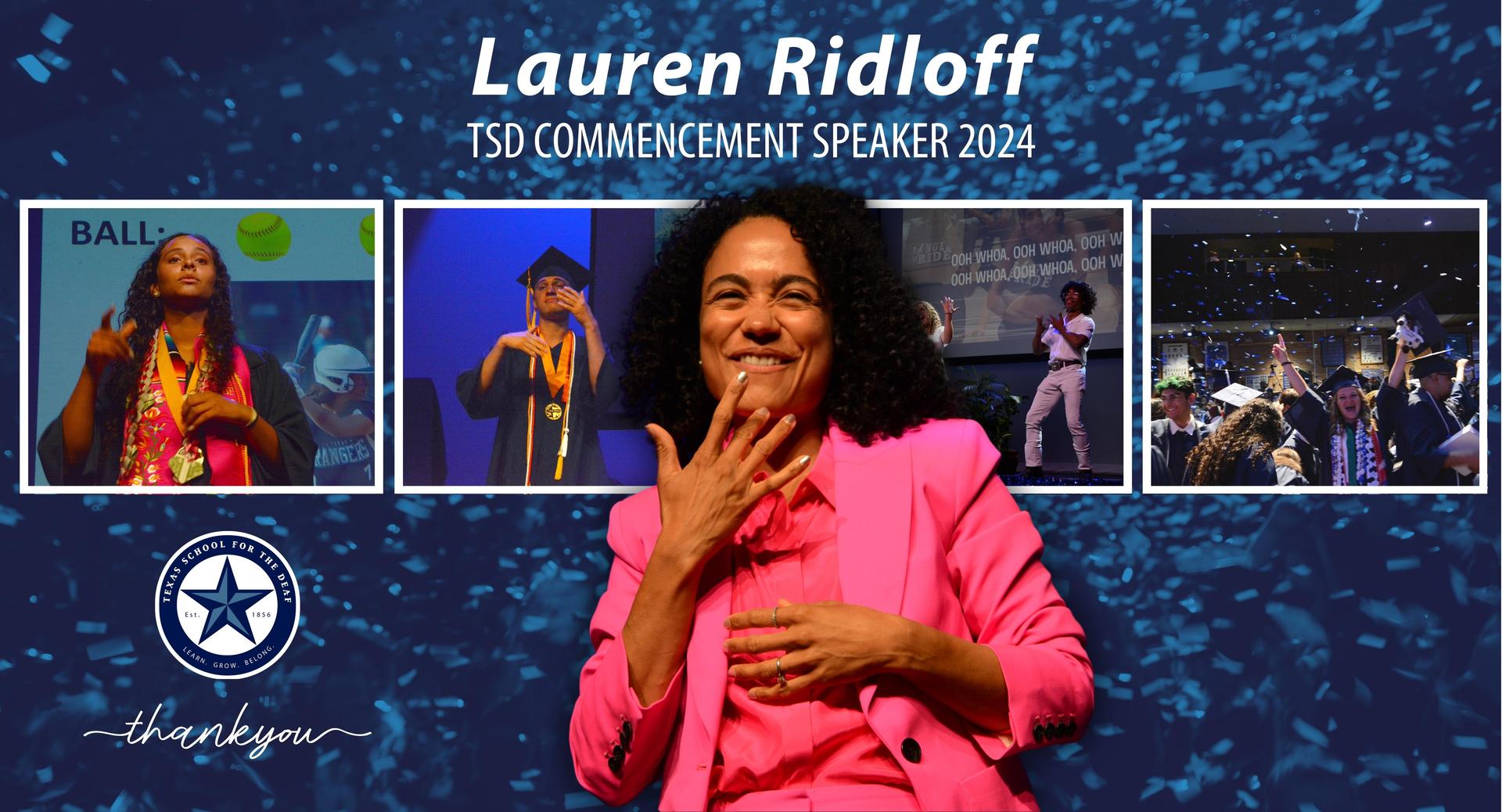
Lauren Ridloff: Inspiring Graduates with the Power of P-A-C-E
By Gabriel Cardenas
Fans recognize Lauren Ridloff for her groundbreaking role as Makkari, the first Deaf superhero in the Marvel Universe. Her portrayal of the super-speedster has significantly advanced representation in the superhero genre.
The Texas School for the Deaf had the honor of having Ridloff address the Class of 2024 at their graduation. Her speech focused on the themes of perseverance, adaptability, commitment, and encouragement, encapsulated in the acronym P-A-C-E.
Using personal stories from her career and life, she made these concepts relatable and inspiring, providing a powerful reminder of the life skills necessary for post-graduate success.
Ridloff illustrated perseverance by sharing her experience training for the New York City Marathon, saying, “When I’m running, I have to pace myself… If I find the right speed, if I find the right pace, I can persist, I can continue.”
Ridloff discussed the importance of adaptability, recounting her challenge of playing the role of Makkari and having to adapt to running in a complex superhero suit.
During a particularly tough running scene inside a large travelator, she felt claustrophobic and considered giving up. However, her commitment to the role and her team kept her going. “I took a moment, and did some self-talk. I knew that there were a lot of people, a lot of crew, coordinators, and stunt performers ready for this big day. I couldn’t not do it. I had to move forward.”
When the movie was released, Ridloff was moved to see a Deaf performer on the big screen as a superhero. Watching her two boys play with a Lego Makkari figurine, she felt the full reward of her hard work. “All of that work, time, commitment, and training was all worth it,” she said.
Ridloff’s final message emphasized the importance of finding and maintaining one’s pace to ensure both success and enjoyment of life’s journey.
She encouraged the graduates to take pride in their achievements and to create their paths at their own pace. “Maybe you feel like you’re not getting where you want to be. It’s important that you are at your pace. Find your perfect pace, that’s yours.”
Superintendent Peter Bailey presented Ridloff with the Claire Bugen Legacy Award of Merit, a prestigious honor recognizing individuals who have demonstrated exceptional commitment to the Deaf and hard-of-hearing communities.
From TSD to Tokyo
The Deaf Grappler’s Journey to the Deaflympics
By Lone Star
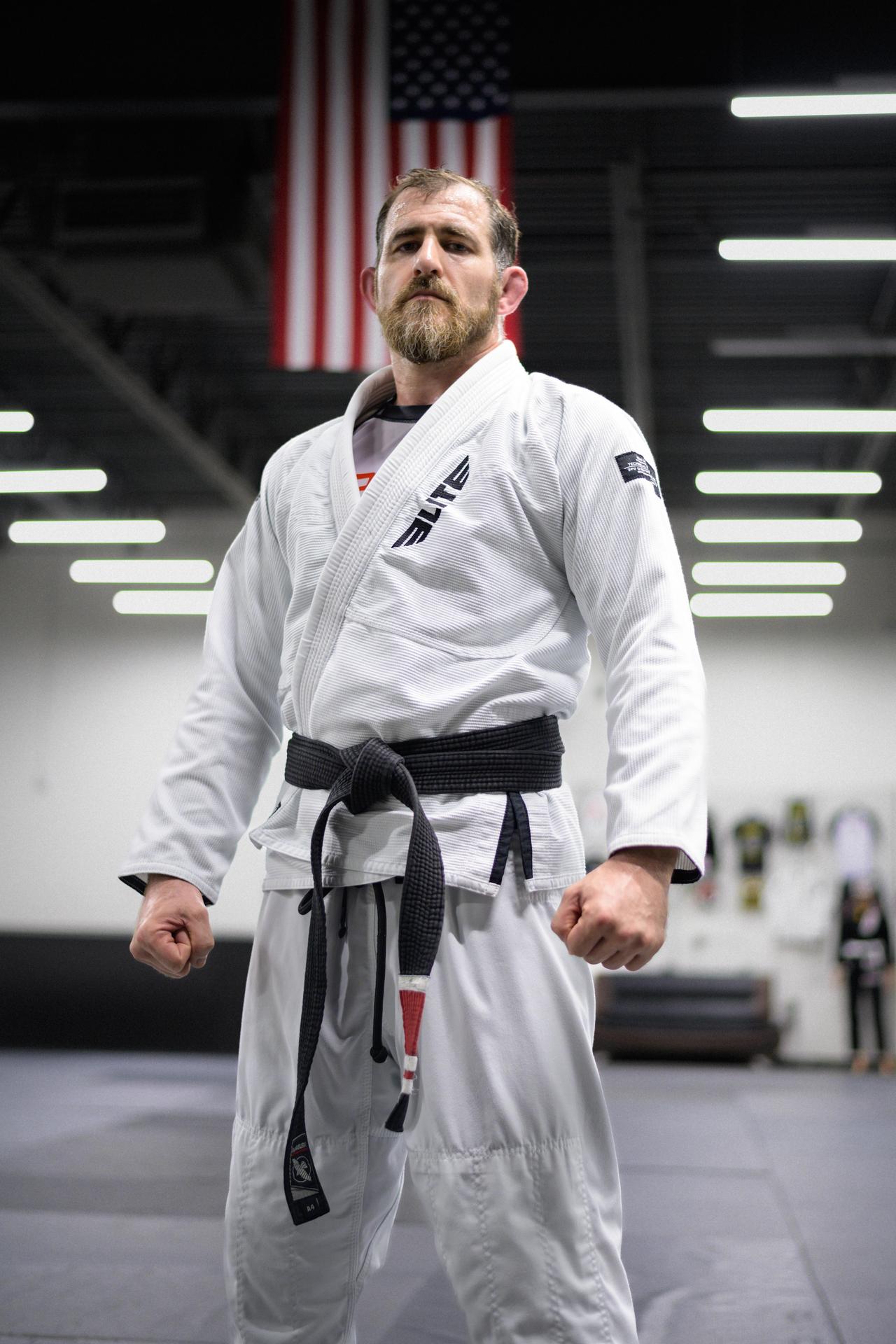
Lone Star is excited to bring you an inspiring interview with Garrett Scott, also known as “The Deaf Grappler.” A proud graduate of the Texas School for the Deaf’s (TSD) Class of 2003, Scott recently qualified for the 2025 Deaflympics in Tokyo, where he will compete in Judo. Scott’s journey from TSD to becoming the first American Deaf man to earn a black belt in Brazilian Jiu Jitsu is nothing short of remarkable. His story is a testament to the power of perseverance, discipline, and the incredible support system he found at TSD.
In this interview, Scott shares how his time at TSD shaped his early years in wrestling, providing him with the confidence to tackle challenges both on and off the mat. He talks about his transition from wrestling to Brazilian Jiu Jitsu (BJJ) and how, despite his love for BJJ, he turned his focus to Judo after realizing its significance in the Deaflympics. Scott’s dedication to his craft, from missing vacations to refining his skills under the guidance of top Judo coaches, highlights his unwavering commitment to achieving excellence.
Scott also offers valuable advice to current TSD students, encouraging them to prioritize education, discover their talents, and train hard to reach their goals. As he prepares to represent the Deaf community on the international stage, his journey is sure to inspire others to pursue their passions with the same determination and heart.
LS: How did your time at TSD shape your journey in wrestling and judo?
I started at TSD when I entered the 7th grade, mainly because in my hometown of Midland, I was going to be the only student who was deaf in my school that year. TSD was an exciting place full of opportunities, but I also encountered some bullies. I played football and baseball during my first year, but I felt that learning to wrestle might give me the confidence I needed to deal with some of the older students. TSD is where I learned wrestling skills, though I didn’t truly excel in the sport while I was there. However, it helped me build friendships, confidence, good sportsmanship, and a love for training. This foundation gave me a step up when I fell in love with Jiu Jitsu later on. I also volunteered as a coach at TSD for several years.
After spending a couple of years at Southwest Collegiate Institute for the Deaf (SWCID), I took Judo classes at Austin Community College. Later, I switched to a Judo club with Che Valdez as my sensei. I earned a green belt in Judo and also learned other martial arts like Muay Thai and kickboxing. I eventually became the first American Deaf man to earn a black belt in Brazilian Jiu Jitsu, and I have since added a first degree to that. I also enjoyed spending a few years as a professional MMA fighter. All of this got its start at TSD—I truly appreciate my time there!
LS: Can you share some of the key challenges you faced in transitioning from wrestling to judo?
I loved wrestling in high school, but then about 16 years ago, I attended a Brazilian Jiu Jitsu class in Keller out of curiosity. I transitioned from wrestling to BJJ, and as I mentioned earlier, I have earned a first-degree black belt. Only in the last year have I focused on Judo, as BJJ is not yet a Deaflympic sport. Judo and BJJ have many similarities because BJJ has its roots in Judo. However, BJJ involves more groundwork and grappling, while Judo emphasizes standing techniques and throws.
This shift has been a big change for me, but one that is helping me grow in my martial arts skills. I’m seeking to train with people who have much more knowledge and ability in Judo than I do now, so that I can level up my skills. I’ve had to think differently as I work out and adjust some of my muscle memory from groundwork to standing techniques.
LS: What does qualifying for the 2025 Deaflympics mean to you personally and professionally?
Qualifying for the 2025 Deaflympics means the world to me! I will be 42 when I finally compete in Tokyo. I had never truly considered it before since my main focus has been BJJ. But, as I explained earlier, BJJ has its roots in Judo. When I went to tryouts in Minnesota in June, I was pretty nervous—but I wasn’t afraid of tough competition. In my mind, I said, “Be water…” I relaxed my breathing and threw down my opponent for the “ippon”!
Next, I faced a man who had won the bronze in Greco-Roman wrestling at the ’21 Deaflympics. I gained control over him and became the 81 kg gold medal winner. It was very emotional for me as I held that medal—ha! I even kissed it. The next day, I found out that I had officially qualified. I’m so happy and very focused on maintaining great discipline and training over the next year and a half. I have a new Judo coach, Nina Cutro-Kelly, gold medalist at the ’21 Deaflympics, and Carrie Chandler, a former Olympian in Judo. I am thankful for my wrestling, BJJ, and MMA experience.
LS: How do you balance your traininng for the Deaflympics with other aspects of your life, such as work or family commitments?
I’m a single guy, but I live near my folks and siblings. I’ve already cut out three planned vacations—including a snow skiing trip (ouch!). Financially and schedule-wise, it’s more important to focus on my training. There are also team meetings to attend between now and November ‘25. I’m very accustomed to training most nights and weekends. I’ve been doing BJJ and Muay Thai classes, but I’ve added Judo, of course. I’m hoping to attain a brown belt before the Olympics.
I want to get in even better shape with lots of drills and cardio workouts, like 5-10 mile jogs. My job, in a warehouse with no AC, helps with weight control. Over the past year, I’ve gotten very serious about meal prep—healthy eating and limited portions. I enjoy lake surfing, golf, and fishing with family and friends. I’m planning on participating in some competitions to build up my Judo experience.
LS: What advice would you give to current TSD students who aspire to compete at an international level in sports?
Hey fellow Rangers! Education is key, so school comes first. Enjoy your PE classes and figure out where your talents lie, and what you enjoy most. Train hard, train daily, and learn from your coaches. If you’re in the DFW area, I teach classes for Deaf students on many Saturday afternoons at the gym—I’d love to see you there!
READ MORE STORIES HERE
Lone Star Journal • Volume 143 • Number 2 • Spring 2024
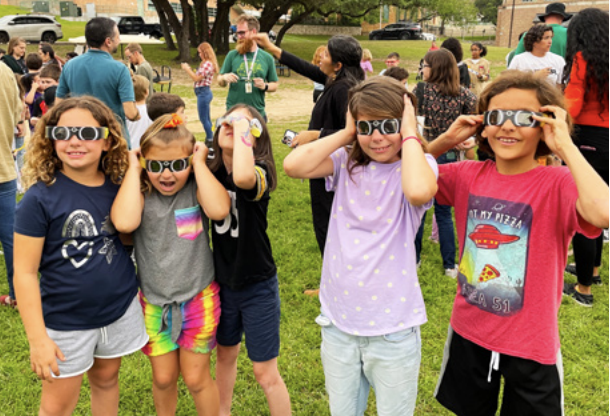

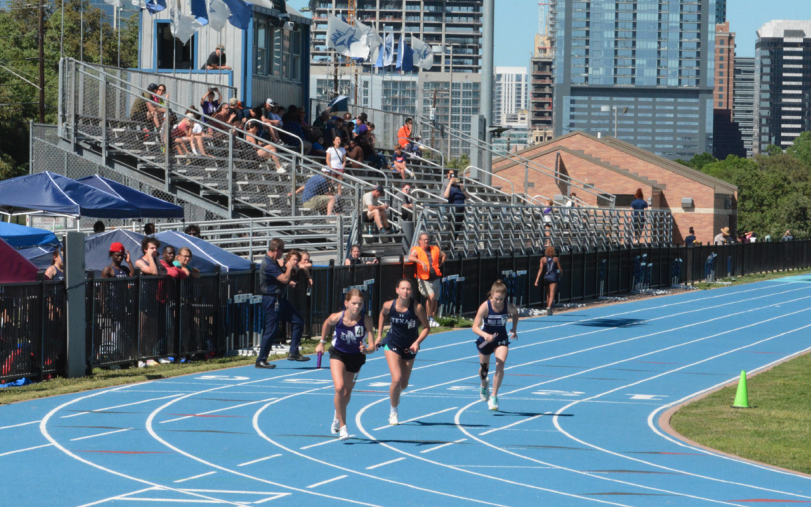
Lone Star Journal • Volume 143 • Number 1 • Winter 2023-2024
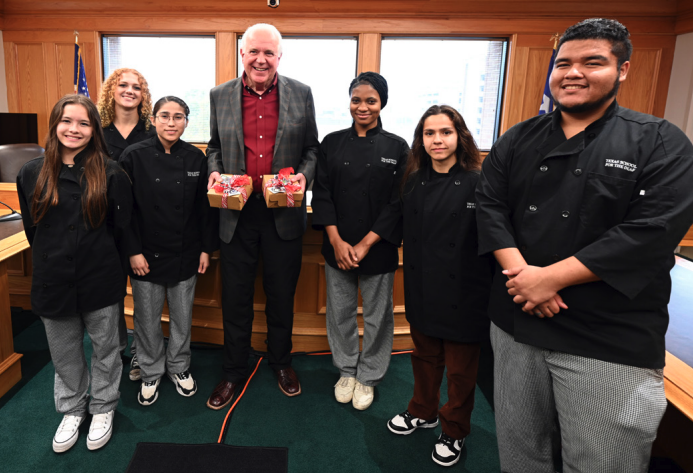
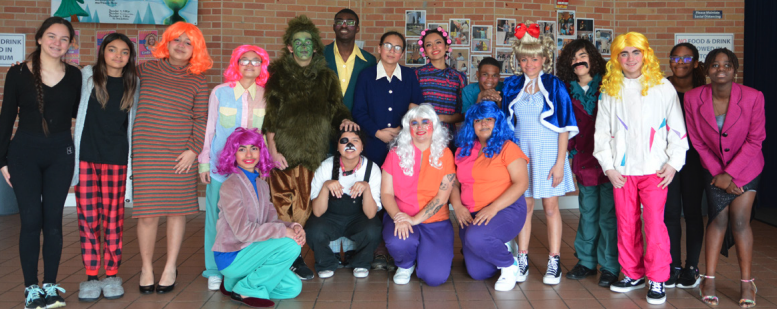
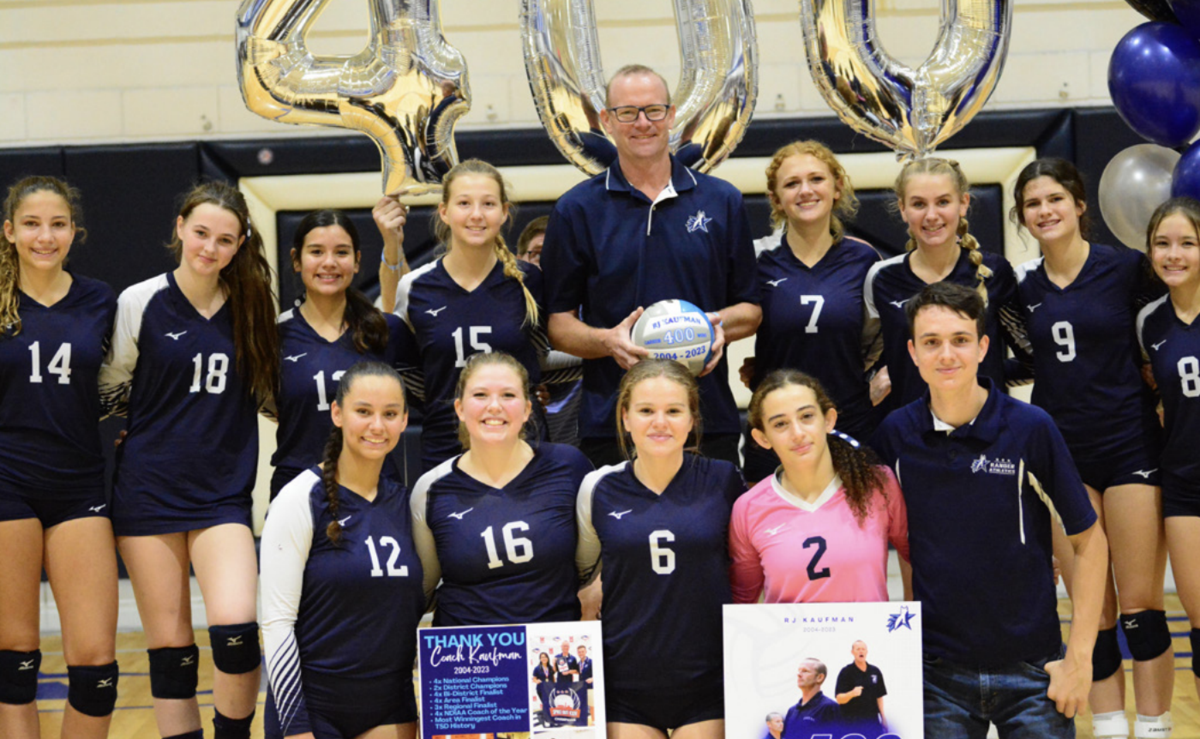
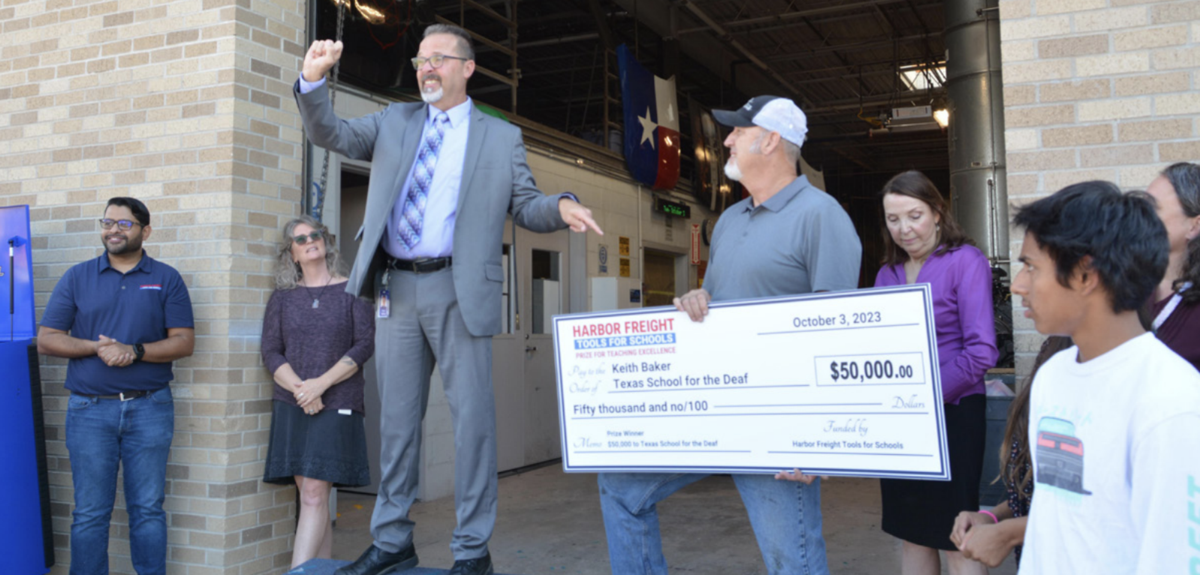
Lone Star Journal • Volume 142 • Number 3 • Summer - Fall 2023
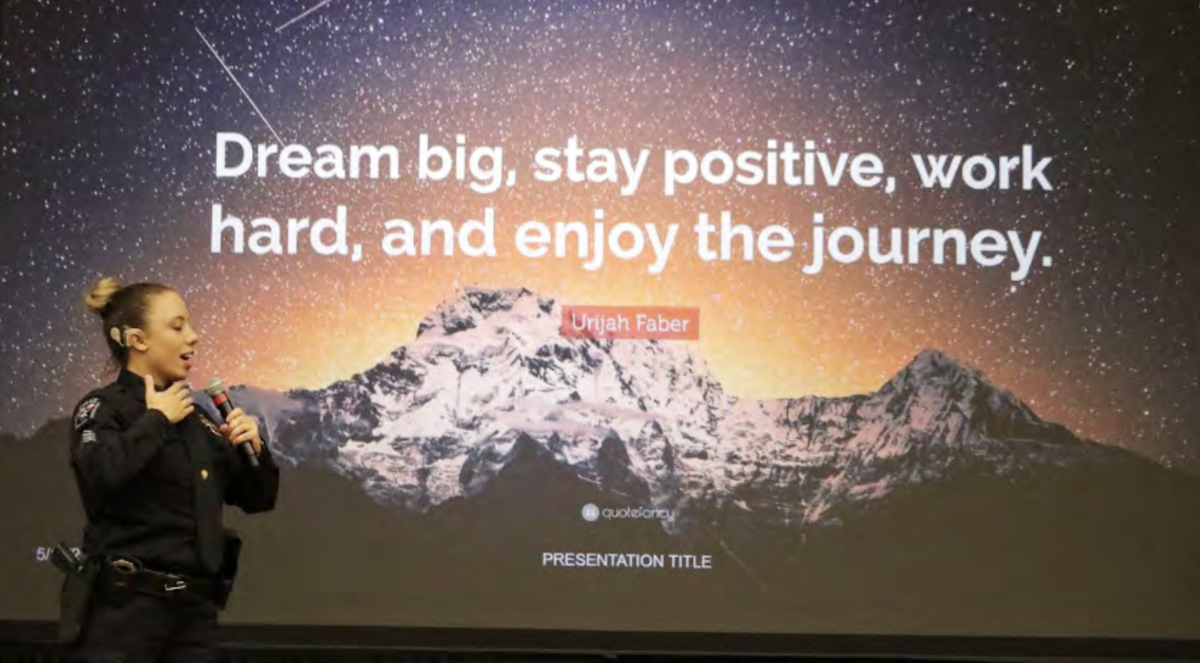
Ava Burke Meets Dalhart Police Officer, Erica Trevino
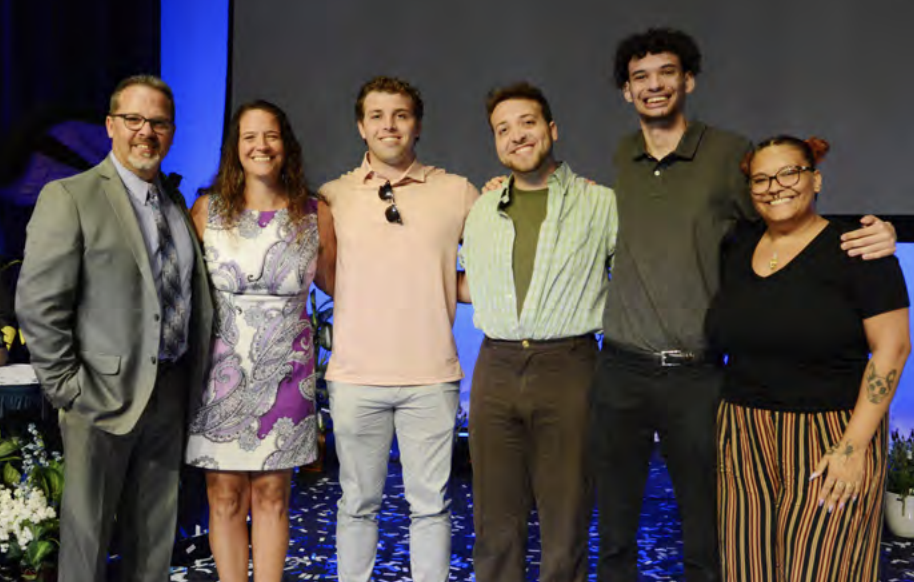

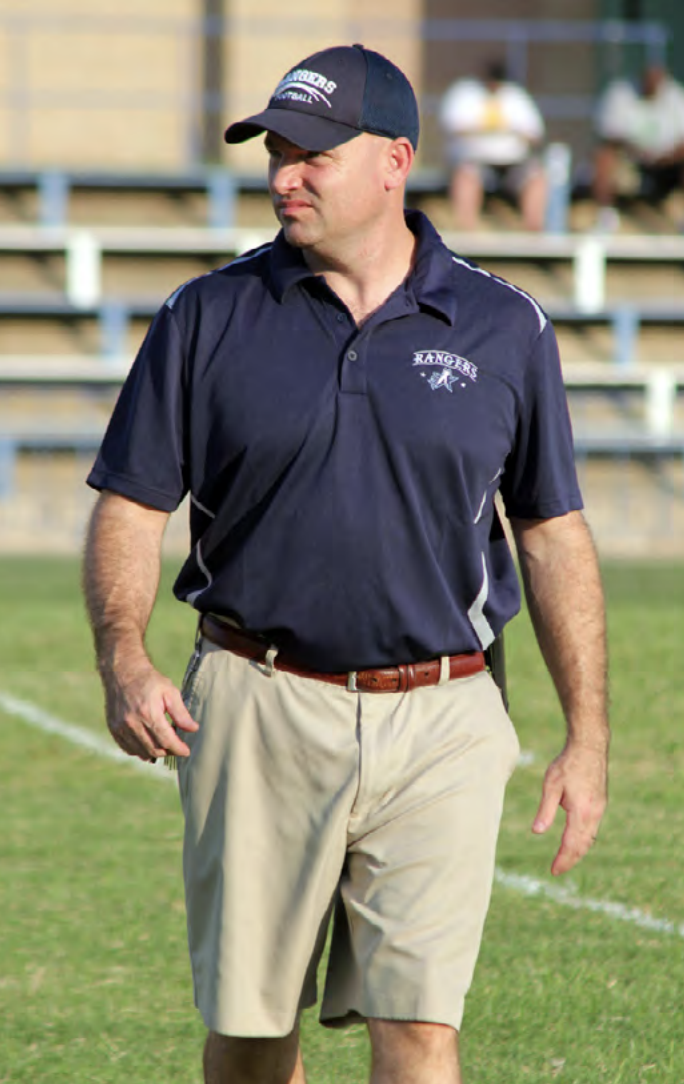
Lone Star Journal • Volume 142 • Number 2 • Special Edition 2023
By Gabriel Cardenas
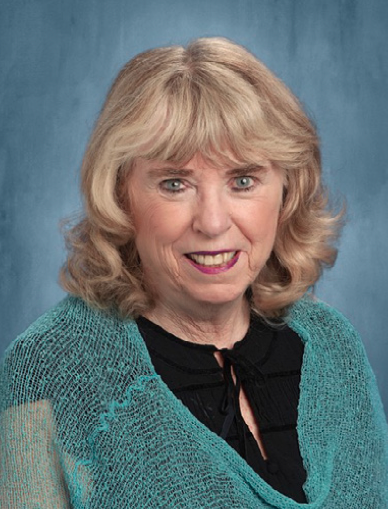
Born on November 14, 1946, in the Bronx borough of New York City and raised in Long Island, Claire received her education in the Hicksville public schools. She completed her Bachelor of Arts in Deaf Education from MacMurray College in Jacksonville, Illinois in 1968, followed by a Master’s in Special Education/Learning Disabilities from the University of Missouri in 1974. She furthered her educational administration coursework at Southwest Texas State University in San Marcos, Texas, in 1982.
Claire’s journey in deaf education began in 1968 as a teacher in the elementary/intermediate department at the Milburn Avenue Day School for the Deaf in New Jersey. She then taught at the W.E. Martin School for the Deaf in downtown Philadelphia and the Missouri School for the Deaf before joining TSD in 1975 as a substitute teacher. Her dedication and commitment led her to become TSD’s Middle School Supervising Teacher the following year. Throughout her tenure, Claire held various leadership positions at the school, including Principal, Director of Education, and Assistant Superintendent.
During legislative budget hearings, Superintendent Claire Bugen never misses an opportunity to remind legislators that the Texas School for the Deaf (TSD) is older than the Texas State Capitol building – the Capitol building was officially completed December 8, 1888.
Established in 1856 with 3 cabins and a smokehouse, TSD has grown to be a state-of- the-art 67-acre campus. Situated along South Congres Avenue, the school has witnessed significant changes over its 167-year history, particularly in the surrounding area, including the evolving Austin skyline, a beautiful view from the TSD campus.
In the 1990s, TSD underwent a multimillion dollar construction project that merged TSD’s East Campus, which previously housed early childhood and elementary programs, with the main South Congress campus. Historically, East Campus had also served as a facility for black deaf students during the era of segregation.
As TSD’s Superintendent, Claire Bugen regularly appeared before legislative budget committees to advocate for funding for deferred maintenance and construction projects, among other needs. However, requests for maintenance and facility repairs often competed with the immediate needs of the growing student population and programs. This challenge intensified when the Governor mandated budget reductions of 5 to 10 percent for government agencies, including TSD, due to fiscal constraints, as was the case in 2013.
During a Senate Finance hearing, a Senator raised concerns about the cost of maintenance and construction at TSD. Claire presented two exceptional items: a request for nine new full- time equivalent positions and another for repair and renovation. In response, Senator Robert Duncan questioned whether the Texas Facilities Commission (TFC) could assume the day- to-day maintenance responsibilities that TSD currently managed alongside its educational functions. As a result, Duncan introduced Senate Bill 1457, which transferred facility management services from TSD and the Texas School for the Visually Impaired (TSBVI) to the TFC.
Senator Duncan stated, “This is an issue that we have observed in the [Senate] Finance Committee over the years as both of these entities [TSD and TSBVI] continue to face deferred maintenance on the remarkable facilities we have provided for these two schools. The bill would allow the schools to focus on educational needs while having TFC maintain the school facilities along with other facilities in Austin.” (Quote from Senator Robert Duncan regarding SB 1457 at the April 2, 2013 Senate Committee on Government Organization hearing) Although change is challenging, especially for a campus that managed its own facilities for decades, TSD established a strong partnership with the TFC. Under Claire’s visionary leadership, TSD developed a new master plan consisting of four phases of expansion to accommodate enrollment, establish campus age zoning, incorporate DeafSpace architectural principles, and increase educational space.
In 2017, the Legislature approved the construction of the Administrative and Welcome Center (AWC) and the adjacent Early Learning Center (ELC). Spanning 2,587 square feet, the AWC was designed using DeafSpace concepts, which promote open communication, particularly through visual language, while considering equity, personal safety, and well-being. The connected ELC was uniquely designed to suit young learners, fostering language, cognitive, communication, and social skills through individual and small group instruction and play.
The transition to TFC managing day-to-day maintenance functions though initially challenging has proven beneficial for the school. Deferred maintenance projects have been diligently addressed, involving numerous repairs, installations, reconditioning, and replacements, resulting in a well-maintained campus.
Further, in 2021, Claire played a crucial role in bringing to the attention of legislators the impact of budget reductions on a school that exclusively serves special education students, particularly regarding deferred maintenance and the continuation of the school’s master plan. State Representative James White subsequently filed HB 3456, which passed and was signed into law by the Governor.
When Claire personally engaged with key legislators and presented before budget committees at the Capitol, her priority remained the needs of TSD, particularly regarding the campus and its facilities, where students acquire knowledge. Her involvement and leadership in designing and implementing the school’s master plan will have a lasting positive impact for years to come.
Lone Star Journal • Volume 142 • Number 1 • Winter 2022/Spring 2023
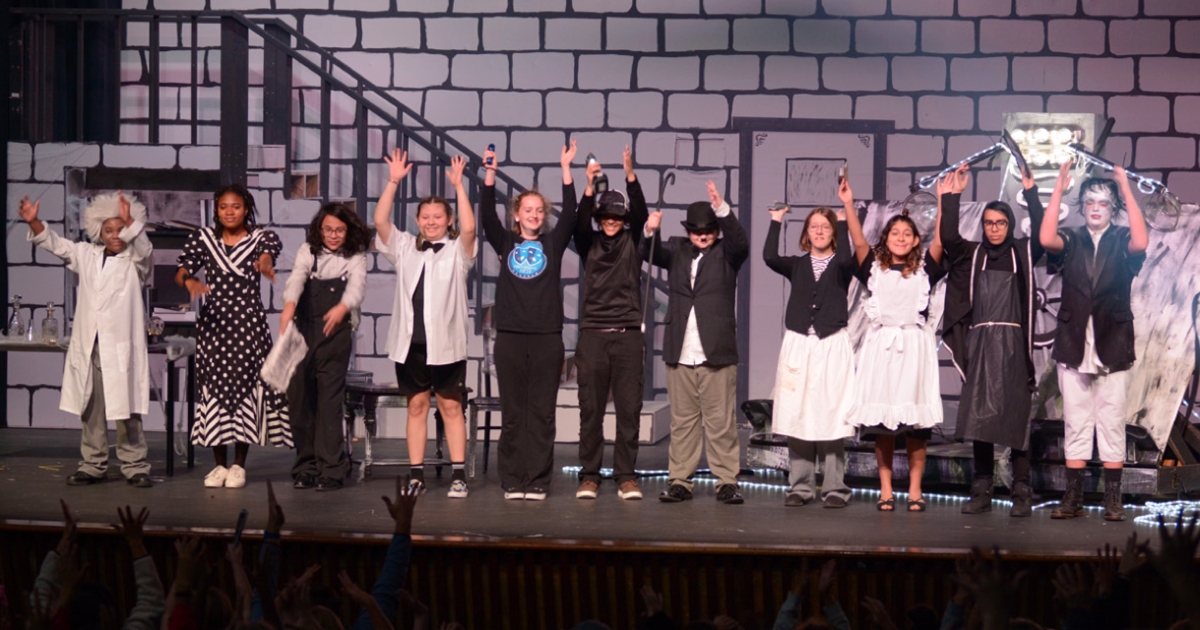
While researching what to present on stage, Theater Arts teacher, Ames Biskupiak, was reminded of the works by Charlie Chaplin, and she recalled Granville Redmond, a renowned California painter who taught Chaplin a technique he later used in his silent films.
Performed entirely using only body language and facial expressions, The Misfortunes of Charlie Chaplin captivated audiences for three performances on a stellarly designed stage built by TSD staff members, Steve Barbin, Stephanie Hurwitz, and Megan Burgess.
The lead role of Charlie Chaplin was played by freshman, Branson Laird, supported by other cast and crew members: TSD seniors, Cindy Alvarez (Houston), Erin Collins (Houston), Ziggy Onion (San Antonio), Jose Ramirez- Vega (Dale), and Bernardo Salinas (Laredo), TSD juniors, Jumoke Olanrewaju (Houston), and Alma Robinson, freshman, Axo Robinson (Austin), middle school students, Jacob Camacho (San Antonio), Elliana Meems (Round Rock), and Julissa O.

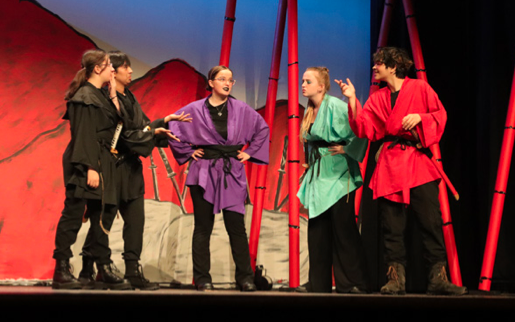
The Seventh Blade, a story by Peyton John Yevich.
By Isabelle Morgan (student contributor)
The story is a perfect blend of action and comedy, with sword fighting scenes in the first act, and humorous one liners throughout the show. It proves the peak of deaf theater with the entire show being told through American Sign Language with accessible voice interpreters bringing out the personality and flavor of each character.
“I very much have high hopes for this upcoming production,” Peyton Yevich states in an interview about the performance. “I consider it as my chance to show the world what I can do to create a world filled with secrets and stories.” “The Seventh Blade” takes place in a Japanese fantasy world, known as the Elysium Regnum.
Throughout the show, references of Japanese mythology and culture are heavily referenced in clothing, sets, and dialogue. “There were many inspirations to name, but the most prominentout of them, I would say, is the Kingdom Hearts franchise,” Peyton John Yevich says when asked for the inspiration behind “The Seventh Blade.” “It was my childhood game, and I loved to replay it multiple times. But an idea, a story of my own with my own characters, began to sprout during my younger years. Then I started to piece multiple inspirations together to create the story, ‘The Seventh Blade.’”
The production opens up in a lighthearted atmosphere. The main protagonist, Lani and his two friends Shiro and Tsukiko, have a friendly and supportive relationship with one another. However, the production is quickly revealed to have a dark side. Sword fighting, moral dilemmas, sacrifice, first crushes -- this play has it all. Unlike a typical “chosen one” trope, Kani is built empathetic, he is evident in his flaws, and he strives to be better for himself and his friends. Younger members of the audience can relate to such topics of comparison to a sibling, having a first love, and playful banter between best friends, all while maintaining the prime theme and moral o the story.
“It’s okay to change and abandon the old beliefs that don’t work out for you anymore,” quoted by Director Peyton John Yevich. “In our current society, people are scared of changing. But in this production, I want to send out the message that it is okay to change. It is important to be yourself and changing can be a factor in that.”

A Celebration of Inclusivity and Creativity
By Rachella Moore
Deaf Austin Theatre is a nonprofit organization that aims to enrich, inspire, educate, create, and entertain the Austin community by using ASL in all theatrical productions, ranging from classics to new works. The integration of ASL and English in the Cinderella production was a monumental achievement in bringing together the deaf and hearing communities.
Co-directed by Michael Baron, ZACH’s Producing Artistic Director, and Dr. Brian Cheslik of Deaf Austin Theatre, the cast was made up of both deaf and hearing actors who worked together to create a truly collaborative and inclusive performance. The show was performed in both English and ASL, with a creative and seamless integration of the two languages.
The collaboration between TSD and ZACH’s production team, along with Leila Hanaumi, an Austin resident who is deaf and a parent of two TSD students, resulted in a stunning translation of the songs of the production in artistic ASL. Leila contributed to the Cinderella performance as the Assistant Director of Artistic Sign Language, to ensure the delivery of the creative and captivating songs in ASL, especially for audience members who rely on sign language to follow the story. She also took on an ensemble role for the last couple of shows.
The production was a shining example of what can be achieved when we work together to create a more inclusive and creative world, and highlighted a new status quo for any theatre goer’s experience.
The production showcased the incredible talent of the deaf and hard of hearing community, while also demonstrating the power of theatre to bring people together. Be sure to check out Deaf Austin Theatre’s website for their upcoming productions! www.DeafAustinTheatre.org
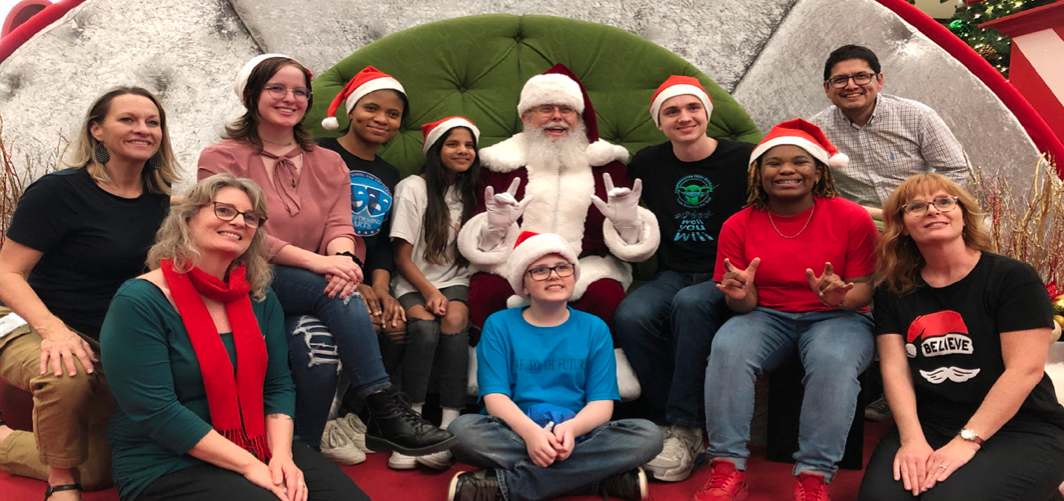
made a grand entrance to the set ready to meet star-struck kids at Barton Creek Square before Christmas day. This is Santa Charles, a certified Santa Claus.
Before he was traveling across the country meeting Deaf children and listening to their Christmas wishes, he was Charles Graves, a night residential educator at TSD. In fact, Charles Graves has been at TSD since he was about 13 years old.
Lone Star catches up with Charles to get to know the person behind the red suit.
LS: Tell me about yourself. Where are you from?
I was born in Missouri. I lived in Greece for four years then moved to Live Oak, Texas where I lived for most of my childhood. Currently, I live in New Braunfels with my beautiful wife, Kari Graves. We will be celebrating our 25 years together this July. We have a beautiful 18 year old daughter, Kalei, who is autistic. We have two dogs and three cats – one is deaf, and two are blind. My hobbies include fishing, beaches, and traveling. We host monthly ASL Socials in our hometown, New Braunfels.
LS: When did you first arrive at TSD?
I was a student at TSD from when I was in the 8th grade. I graduated from the school in 1990, then started working as a night residential educator at TSD in 2000.
LS: It seems you have spent most of your life on the TSD campus. How much has it changed since you first arrived?
I remember some of the old buildings. Now, most of the campus has new and modern buildings. We, as students, used to be able to go off campus everyday. Now students can only go off campus on certain days. I was involved with drama, and we used to travel to many different cities, which is something they do not do anymore. Of course we all dressed differently in those days. Signing (ASL) has changed over the years too. Now the students go home every weekend, back then students went home for the holidays & summer only.
LS: What was your fondest memory while attending TSD?
Picking on the teachers and staff. Hanging out with friends, walking to ThunderCloud Subs frequently. Being able to sign with the teachers, staff, and students. And participating in PALS (Peers Assistance Leadership). I loved being in drama, auto mechanics & photography classes. And I enjoyed visiting with then Superintendent, Marvin Sallop, at his campus home.
LS: Let’s get serious here. How did you become Santa?
LS: You’ve been featured on numerous local news stations across the country. How does that feel?
It was very overwhelming, in good ways. It felt good to be able to spread the word about Deaf Santa Claus being available for children who are deaf to visit with. We want parents to see the joy and excitement in their children’s eyes when they are able to sign with a Santa who is also deaf, just like them.
LS: Does Santa really know all the names of his reindeers? And does Santa need a license to drive his sleigh?
Yes, I know all the names of the reindeers. In fact, I have a Santa’s driver’s license! It includes my personal information, such as: weight - “fluffy,” eye color - “twinkle,” beard color - “snow white.” The license is valid worldwide. And there is no speed limit on sleighs.
Lone Star Journal • Volume 141 • Number 2-3 • Summer-Fall 2022
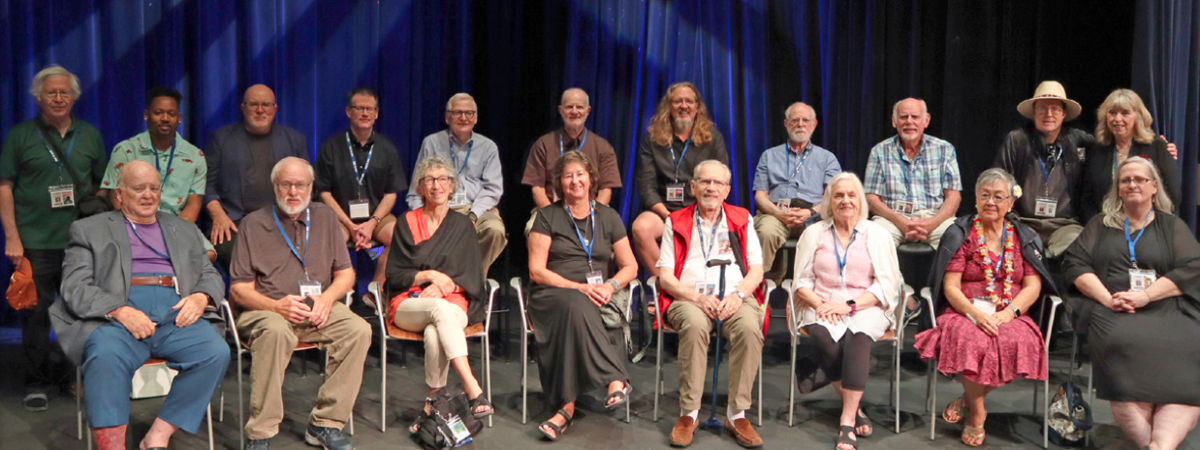
The festival kicked off with a school- wide student assembly featuring high school student, Jayden D., sharing a letter from former First Lady Laura Bush (co-founder of the Texas Book Festival).
Bush’s letter said, “President [George W.] Bush and I appreciate the Texas School for the Deaf for all that you do to help the Deaf community learn, grow, and belong. He joins me in sending our best wishes for a successful and memorable festival.”
The event gave students and the public the opportunity to meet and talk with the various authors about their books and about being a writer. Featuring a diverse selection of written works in a variety of genres, including Deaf culture and history, science fiction, sports, travel, magic, and comic books.
Trudy Suggs, a writer and publisher, brought her son to attend the event.
She said, “my son, who turned 13 on the first day of DABF, was impressed by how many authors there were, how many renowned Deaf community leaders were there, and the opportunities he saw in each and every book there.”
Peggy Ann Wenger, who played a key role in planning the event, saw that many people were inspired by seeing so many authors from the Deaf community.
“It’s not often that we have Deaf authors here for students to meet and learn from,” she said.
Suggs, the founder of T.S. Writing Services and Savory Words Publishing, also said, “When Steve Baldwin came up with the concept of DABF, I was all in, and beyond thrilled.”
“It’s my hope that this festival showed the young people in attendance that they, too, can and should share stories about their experiences as Deaf people, because this is the only way we can reframe the way the world perceives us.”
Lone Star sat with Dr. Steve Baldwin, the co-chair of the DABF and founder of the Deaf TV Foundation, to talk about how DABF became an event and his experience.
LS: How did this become an event?
SB: Actually, the seeds were planted at TSD via Deaf Television Foundation. Superintendent Claire Bugen, TSD Ranger Press, TSD Athletics, and Student Life Department agreed to co- host three Deaf authors’ book signing events and writing workshops for students and adults in 2019.
Thanks to grants from TSD Foundation, Humanities Texas and other donors, we hosted the literary event at TSD. But we lost a year-and- a-half from having a third event due to COVID-19. On the bright side, it gave my foundation and TSD ample time to plan for May 2022. We received more grants and donations and 25 Deaf authors agreed to come to the Deaf Authors Book Festival. In actuality, it took a year-and-a-half to plan.
Plus, it was time for the world to know that we have wonderful books by Deaf authors with their bona fide Deaf perspectives. Too many books about the Deaf have been written by hearing authors in the last 50 years.
LS: What was the inspiration for this event?
SB: Good question. A contributing factor was the Texas Book Festival, which started in 1995 by First Lady Laura Bush (she sent us a congratulatory letter) and Mary Margaret Farabee. I attended and learned from that major literary event and was duly inspired. But only three Deaf authors have participated in The Texas Book Festival, to my knowledge, in the last 37 years. Personally, I don’t think it was that accessible. Competition is keen, with only 300 authors out of a thousand invited.
At national Deaf gatherings, I rarely see Deaf authors selling or signing books. Therefore, we needed to do it ourselves by finding sponsors, inviting Deaf authors, and designing our criteria.
LS: What was the criteria used in selecting authors?
SB: A criteria was decided in selecting authors to attend the event: 1.) Published book after 2015, and 2.) Approved genres: Deaf culture, Deaf history, biography, Deaf literature, and memoir. It was decided that no sign language books or Deaf education books would be considered since there are so many and most written by authors who are hearing.
Plus, I know most of the invited authors personally too, and it’s great they all agreed to come to Austin. It’s rare to have more than two authors together in a location.
LS: Share with the readers about the event itself and the experience.
SB: The event itself was a resounding success for having 20 Deaf authors all the way from Hawaii to Maryland, to Florida and California, as well as from Texas. The experience taught us that we can have a national literary event for Deaf authors that’s never been done. Due to the large size of people attending the event, plus TSD students and staff, the event was largely well-attended and well-received.
We also had two successful panel discussions, which were well- attended and impactful.
One media professional mentioned, “who knew there were so many Deaf authors around?”
LS: Do you foresee future events like DABF on the horizon?
SB: I foresee that several Deaf organizations, statewide and nationwide, will have panel discussions for Deaf writers and literary events. Let’s wait a year and see what else will happen before determining the substantial impact of the DABF.
LS: Any final thoughts or recognition?
SB: Peggy Ann Wenger, a Student Development supervisor at TSD, was my right-hand person, and played a major role in the success of the event.
1. Stephen C. Baldwin - “Backspace” (2015)
2. Donald Bangs - “My ASL Book” (2018)
5. Simon L. Carmel - “Out of the Magic Cloak: Biographies of 68 Deaf Magicians from 23 Countries” (2019)
12. Raychelle L Harris,
13. Topher Gonzalez Avila, Jean F. Andrews - “Deaf Culture: Exploring Deaf Communities in the United States” Second Edition (2022)
17. Ronald E. Nomeland - “The Deaf Community in America: History in the Making” (2013)
20. John Cartwright II - "The Deaf Black Man" (2020)

and families.
Performing as a rapper since 2005, Wawa became a viral sensation following two Super Bowl half- time performances, in 2021 and 2022. It was his most recent performance though, alongside fellow rappers, Sean Forbes, Dr. Dre, Snoop Dogg, Eminem, Mary J. Blige, 50 Cent, and Kendrick Lamar at Super Bowl LVI, that caught the attention of TSD’s class of 2022.
“I was here (in Austin) for SXSW getting ready to present in my panel,” Wawa said. “I was ready to go when Superintendent Bugen surprised me and said, ‘I have a letter for you. Don’t open it until you’re finished.’ So, I tucked it into my jacket.”
“I had forgotten about the letter when I later found it in my pocket. It was from Trey at TSD, inviting me to speak here today. I was awestruck!”
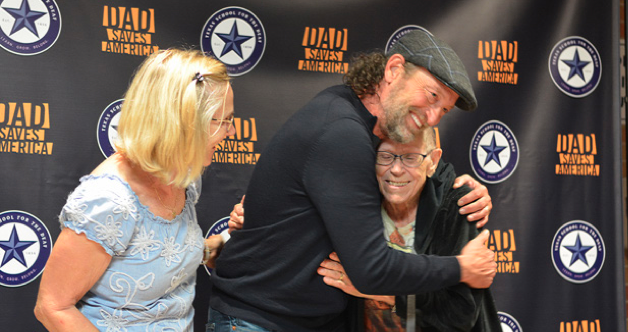
the Academy Award for best supporting actor in CODA (2021).
“My dad, he was the best signer in our family, but he was in a car accident, and he became paralyzed from the neck down, and he no longer was able to sign. Dad, I learned so much from you. I’ll always love you. You are my hero.”
After filming around the campus, Troy found time to give TSD theater students a short impromptu workshop. After the workshop, one student commented, “He’s become one of my role models. I would love to be an actress so that I can communicate and give hope to other deaf or disabled individuals.”
Troy took the stage at the R.L. Davis Auditorium to talk to his fans about life as an actor who happens to be deaf. In his address, he spoke about the relationship between him and his father.
“My father was so important to me, because he made me what I’ve become today. And that’s because of everything he taught me, loving, caring, and really everything. He was involved in my life and I was involved in his life too,” he explained in a segment that was then used for a Father’s Day message.
After his speech, Troy shared what he hopes to instill in young deaf actors to Spectrum News, “That’s why I speak to these kids. To inspire them. To give them hope. There is so much room for creativity and there are so many opportunities. I don’t want these kids to limit themselves. And if I can do it, that means they can do it too, especially deaf children...”
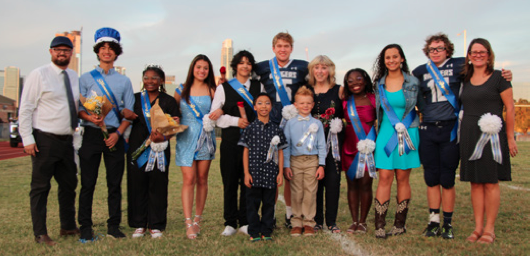
By Claire Bugen, Superintendent
I love seeing the Ranger community come together in support of our students!
The Homecoming spirit week celebrations in all departments were loads of fun!
The Class Competitions for best poster designs, best spirit, best attendance and those wonderful “brownie” points made for an entertaining morning!
The Blue and White Pep Rally with Rangers young and old celebrating together in person was inspirational!
The Homecoming Dance and the 55 carnival booths representing all aspects of the TSD community provided a fun afternoon for all.
Honoring our former Homecoming Queens at pre-game is a bit of nostalgia that is a prized TSD tradition.
Lone Star Journal • Volume 141 • Number 1 • Winter 2021/Spring 2022
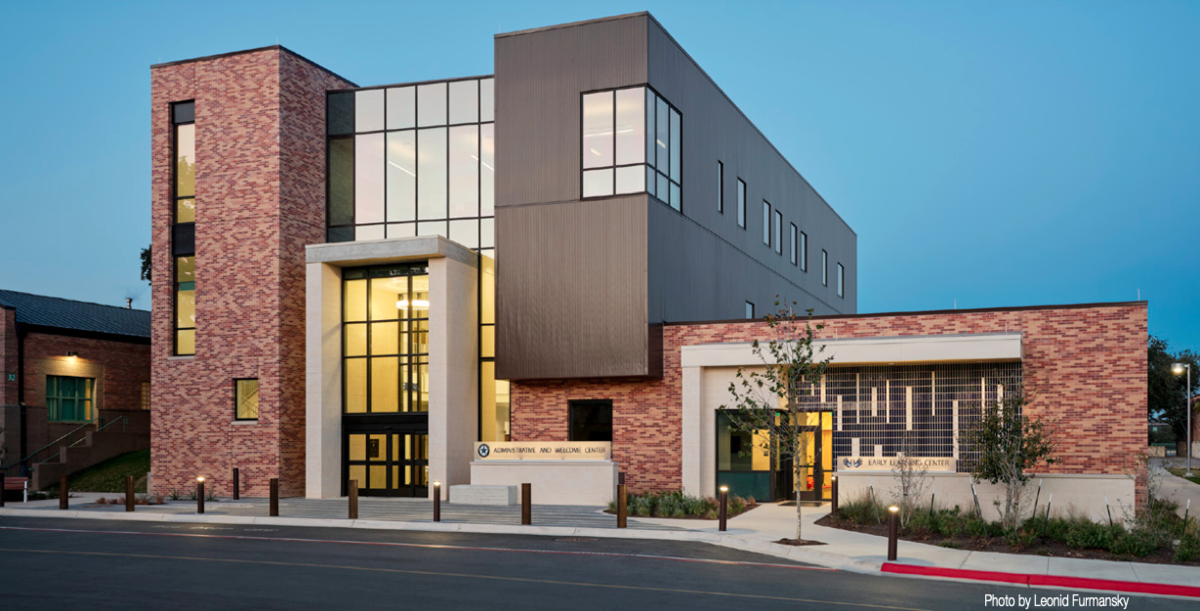
The New Administrative and Welcome Center & Early Learning Center
By Gabriel Cardenas
Building onto the school’s rich 166-year history, TSD’s newest construction officially opened with a ribbon cutting
and open house on February 24, 2022.
In 2017, the Texas Legislature, as part of TSD’s campus master plan, appropriated $14.6 million in Economic Stabilization funds for the construction of the new facility. Ground was finally broken in spring 2020 after months of meetings and collaboration with the Texas Facilities Commission (TFC).
With 2,587 square feet, the new building includes both the Early Learning Center (ELC), adjacent to the Administrative and Welcome Center (AWC) and was designed using the concepts of DeafSpace.
While not often considered in construction or design planning, DeafSpace is important for TSD and other places where members of the Deaf community congregate or hold meetings. DeafSpace design promotes and encourages open communication, especially with a visual language, along with considerations for equanimity, personal safety and well-being.
ELC is a unique and inclusive family and child centered program for deaf and hard of hearing students from birth to prekindergarten. The center is designed with the scale of young learners in mind, to grow their language, cognitive, communication and social skills through individual and small group instruction and play.
The AWC is an open-designed meeting and office space for the superintendent’s and business services’ offices. The airy, first floor lobby is a gathering space for social functions, and includes one conference space for meetings.
The second floor includes a new Governing Board room and a flex space that can be combined or divided into three separate meeting rooms.
The superintendent’s office, business services’ offices, and an executive conference room are located on the third floor. All conference rooms and event spaces are fully equipped with audio and video capabilities.
During the official grand opening, former Governing Board President, Eric Hogue, said, “This new facility is a reflection of our Deaf community’s passion for early learning for our students, and for providing a warm and welcoming DeafSpace design for our stakeholders.”
“They are our number one priority.”
Representatives from student organizations, Deyon Robinson and Timara Allen (Black Deaf Student Union), Bre’asia McDade (PRIDE), Jose Flores (Manos), Trey Johnson (Jr. NAD), and Anahit Tadevosyan (Peer Assistance and Leadership) were selected to serve as ambassadors and led guests on tours of the new ELC and AWC.
Vince Leibowitz, Legislative Director for Senator Royce West, said of the new facilities, “It was very exciting to see the new Early Learning Center and Administrative Welcome Center at Texas School for the Deaf.
“This state-of-the-art facility will enhance early childhood development for deaf children in Texas for decades to come, while the administrative center will provide a beautiful warm welcome to families, students, and visitors.
“It is great to see everything going on at TSD to serve these students.”
Senator West sits on the Senate Finance Committee andwas a key supporter in appropriating the funds for the new building.
Beautiful and delicious refreshments were served by TSD’s Culinary Arts students along with instructor, Felipe Bonafacio, and Christophe Milani, Susie Giuntoli, and the TSD cafeteria team.
Bugen says, “We are excited to see these new facilities be that bold reflection of our commitment to our mission to serve deaf and hard of hearing students here on campus in Austin, and to support students, families, and professionals in deaf education across the state.”
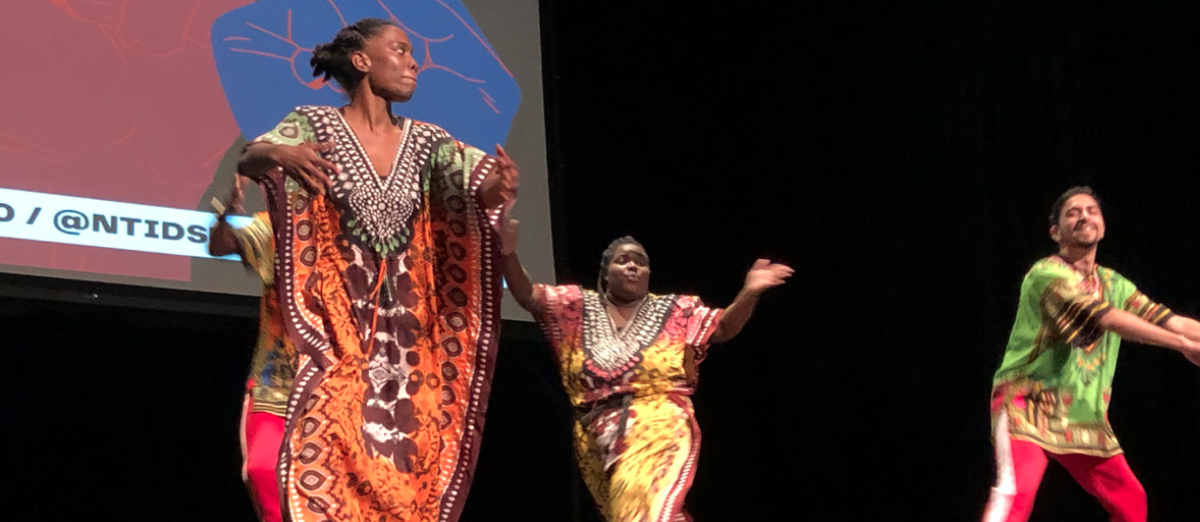
By TSD Superintendent, Claire Bugen
TSD’s Director of Instruction, Stella Egbert, kicked off Black History Month with a message to school staff celebrating the richness of Black history.
“There is no American history without African American history,” said Sara Clarke Kaplan, executive director of the Antiracist Research & Policy Center at American University in Washington, D.C. The Black experience, she said, is embedded in “everything we think of as ‘American history’.”
Stella further encouraged everyone to learn more about our Black community members, listen to their stories, their experiences, and what wisdom they pass onto their people and multiple communities.
Every year, Black history month has a theme. This year, the theme is Black Health and Wellness. Not only do we recognize Black scholars and practitioners, we take the opportunity to think further about how the Black community considers wellness as a foundation of strength to the community. Incredible achievements have been made by individuals, for many if not all, through oppressive strife within the community and have generated contributions that may go unrecognized. During this month, we try to bring it to the forefront. It’s important to also recognize how we can remove disparities in healthcare and access to wellness. Like Ibram X. Kendi said, “it is us that reinforces or dismantles racism.”
TSD’s Public Information Officer, Gabriel Cardenas, also contributed to our acknowledgment of Black History Month. Each week, Gabe sent out excerpts from an article written by former National Black Deaf Association (NBDA) President, Benro Ogunyipe, with thought provoking questions meant to stimulate conversation within our community. Some of the topics shared related to: history, culture, and education of Black Deaf people; the Black Deaf community and its stories, accomplishments, and recognition; Black ASL in media and social media; TSD’s Black Deaf history; the various resources, advocacy, and outreach organizations; and tips on how to teach Black history in culturally responsive ways. A webpage was created and serves as a depository where teachers can view, borrow, and share information year-round: https://www.tsd.state.tx.us/apps/pages/Deaf_Black_History.
TSD’s Black Deaf Student Union (BDSU) organization, led by sponsors, Taurean Burt and Marcus Sylvester, had the opportunity to address TSD’s Governing Board at the February 25 meeting. Two BDSU students went before the school board to explain that “the BDSU was established in 1997 to bring awareness of our heritage and our culture.” They further noted that there are about 35 Black students in the TSD high school, with roughly 20 that are involved in the organization.
“We have Black girl magic, we have Black excellence, and we want to talk about the excellent qualities of our community.”
The students went on to share with the board some of the discoveries of Black Americans that have made a difference in all of our lives. They spoke of the plasma bag, which was created by Charles Drew, to aid in drawing blood; the elevator, that was created by Alexander Miles; X ray technology, which was created by George Alcorn; and Global Positioning System (GPS) technology, by Dr. Gladys West.
Superintendent Bugen asked the students, “I’m curious, do you have any suggestions for us here at TSD as to how we can do better to recognize the BDSU and the contributions of Black Deaf people?”
The students suggested “recognizing black excellence, andhaving Black performers to come in. And for those who can, come be involved with our BDSU and reach out to our members to talk about it., as well as giving
presentations during Black History Month.”
Superintendent Bugen asked the BDSU sponsors the same question, who said, they “would like to see more support from the entire TSD community, and not only depend on the BDSU to take the lead. The hope is more partnerships, in addition to more scholarships to support Black Deaf students.”
Black History Month culminated with a visit by the Sunshine 2.0 performance group. This traveling road show entertained TSD audiences with both beautifully interpreted musical theater and educational workshops. Sunshine 2.0 is a professional traveling theater troupe based at the National Technical Institute for the Deaf at Rochester Institute of Technology. The troupe absolutely inspired TSD students with their messages of how to change the world.
Superintendent Bugen commented that the troupe’s ASL translation of Michael Jackson’s “Man in the Mirror” brought to life the message about making change and realizing that it starts with YOU - to make a difference on the outside, you have to first start from within.
TSD staff member, Bridget Dryden, said she “loved dancing with the middle school kids, and that the gathering reminded her of the old Black History programs of the past.”
Thank you Sunshine2.0 for inspiring all of us to be the best versions of ourselves.

We had 20 students from Bastrop classrooms along with some TSD students. It was an exciting time for all to come together. It is always a joy to see the students interacting with one other.
To kick off the festivities, Theron Parker signed the holiday story Pig the Elf, written by author Aaron Blabey. The students watched in wonder at the story of a dog named Pig who loves the holidays. Pig loves the holidays because of all of the presents, presents and more presents and decides to stay awake so that he can see them as soon as possible. He wants his presents now so decides to stay up all night. The students laughed as they related to Pig’s anticipation.
Next, everyone played a classic game that many of us can remember: Red Light, Green Light! It was an absolute hit with the kids, despite being an age-old game.
Later, the students devoured pizzas while Santa was getting ready behind the scene to greet the crowd. While they were snacking on cookies and drinks, Santa came out and surprised them. They were filled with such joy! Some might say that Santa shares a striking resemblance with our very own TSD community member, Tom Withrow.
The holiday season may have come to an end, but the fun isn’t over. SOC has offered ASL Storytelling classes via conferencing for deaf and hard of hearing students across the state of Texas, since 2000. Originally, starting with only four classes, but over the next 20 years, ASL Storytelling has expanded and now serves over 300 deaf and head of hearing students with seven excellent ASL storytellers. The ASL Storytelling Program is a free program and is a unique, interactive experience for participating young minds from all over Texas.
Lone Star Journal • Volume 140 • Number 3 • Winter 2020/Spring 2021
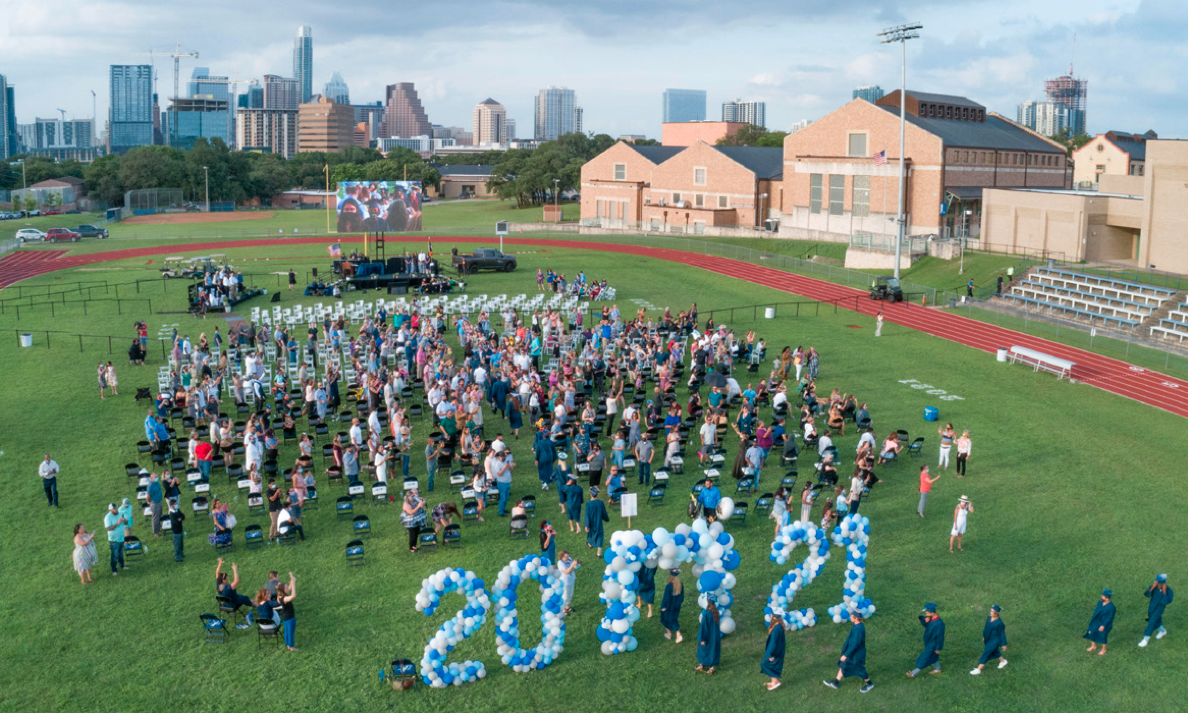
Showering 2021 graduates with lots of love— plus, amazing student performances, and insightful student speeches and advice—can help take the sting out of many of the losses of these past 18 months.
It had been 25 years since a TSD graduating class had an outdoor ceremony and this year was one for the record books. A towering LED video movie screen with the City of Austin as a backdrop came as close to providing a perfect evening as we can get at this time of year.
TSD traditions such as the invocation provided by the recent Kinder graduates (Class of 2033) and the seniors who themselves started at TSD in Kindergarten and the CTE Video Technology class senior tribute song “FLY” was once again a favorite for the audience.
Our superintendent, Claire Bugen used the senior’s mascot Stitch to send a loving tribute to the Class of 2021 remarking on their patience, resilience and courage over the past 18 months and wishing them Stitch’s passion to find his place in this world and do so by spreading love and kindness. She also took time to recognize the selfless and dedicated combined 27 years of service to TSD staff and students by outgoing Board president, Eric Hogue and Secretary Angie Wolf.
Our Salutatorian, Zara Thompson thanked her parents for dealing with her “stubbornness” through many wonderful and heated conversations.
She also reminded her classmates that “Life isn’t perfect” as witnessed by the events of these past many months “but never to give up because the life lessons are worth it.”
In a closing live performance 2021 graduates Yamila Davis, Isadora Egbert, Rosalia Fraychineaud and Annabelle Scroggins brought the house down with their performance of “The Champion.”
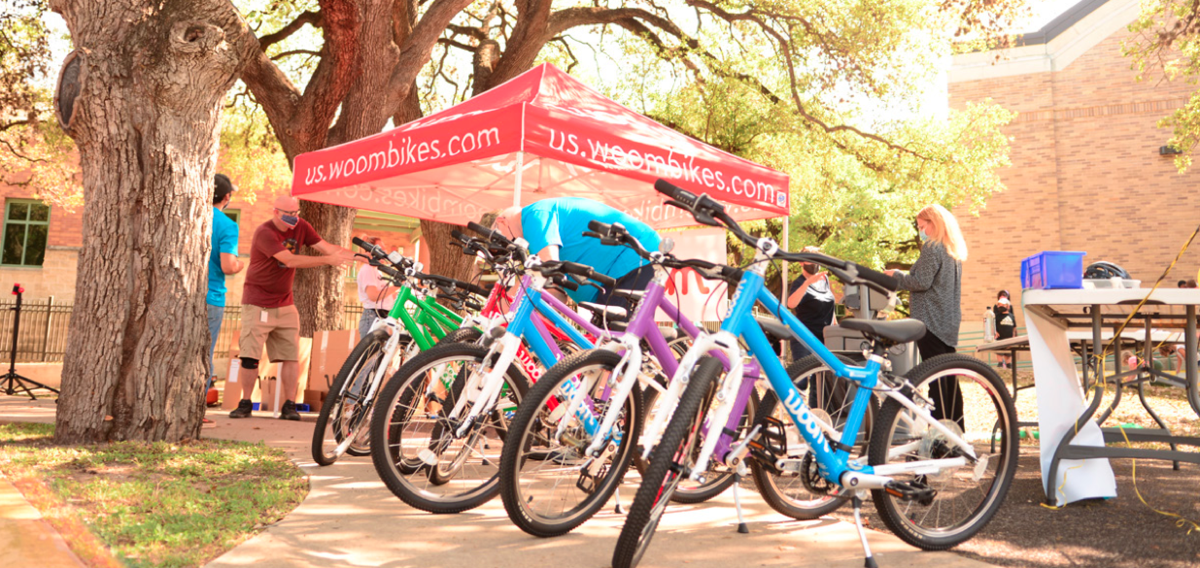
By this time, Juan and Lucero had already gifted over 200 bikes, and were challenged to find and repair more bikes for kids at TSD.
That’s when Mike Rowe of Returning the Favor – a reality web television series - got wind of the project and surprised Juan and his family on an episode where, together with woom, they made a generous donation of 50 bikes to the 100BikesForKids project. 30 of these bikes were set aside for TSD, and the remaining 20 bikes were distributed to kids and schools in the north Austin community.
“When our campus becomes super active in the spring, TSD Superintendent, Claire Bugen, says, this is the perfect activity while we’re maintaining our safe social distances. After school staff and physical education departments are anxious to promote a student bike club and teach bicycle safety.”
“Kids love riding bikes, said Bugen, but it’s not something TSD has been able to provide for the students when they’re here. We are so fortunate Stephen met Juan. We’re grateful to Juan, his family and woom, for giving students at TSD a way to stay healthier and happier. With plans in place to take care of the bikes and keep them safely locked up, they’ll be here for students for a long time to come.”
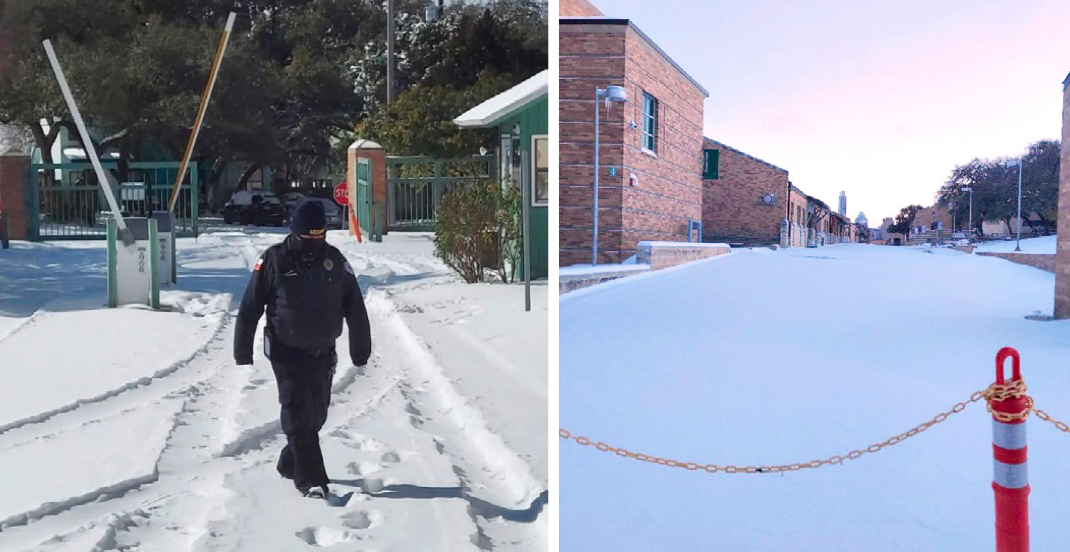
By Devlin Crane, Night Residential Educator and Larry Willis, Day Residential Educator
Just before Valentine’s Day 2021, a harsh winter storm crept into north Texas leaving two students from the Midland- Odessa area stranded at TSD for the weekend. No one knew then, winter storm Uri would soon shut down the entire state leaving many residents without power, food or water for several days.
When Devlin Crane and Larry Willis – two residential educators at TSD – got word about the two stranded students, they both sprang into action braving dangerous and harsh elements themselves, to come to the rescue. Little did they know they’d be in for the long haul.
Here are their stories.
Devlin Crane, Night Residential Educator.
When I heard from my supervisor asking for emergency aid, I volunteered to step in. I live 55 miles from TSD in Giddings, so when I set out, I was shocked to see 1-2 inches of snow on the ground and temperatures already below freezing. I worried about the danger of “black ice” but proceeded with caution.
I saw a lot of cars in ditches and on the medians, some overturned and abandoned with no tow trucks or emergency vehicles anywhere. It started to snow heavily and suddenly I was in a blizzard. A white-out. Driving was becoming difficult, and really scary.
Somehow, I managed to make it to campus and get to the students. Then, that night around 2:00 a.m., a blackout occurred. We thought it might last a few hours. But unfortunately, it remained throughout the night, draining the batteries on the emergency back-up lights.
Early, before sunrise the next morning, my colleague who was to relieve me arrived. When my shift was to end, I tried to go home but the campus gates were locked shut since the power was still out. I realized we were all stranded on campus. After I was able to get some sleep before my next shift, I woke to realize the power was still off. And that meant our lines of communication could be down with no way to charge phones or laptops. Luckily, we still had a cell signal so we could order food, but we didn’t know all stores and restaurants were closed.
We finally reached campus Security who helped us gain access to the cafeteria’s food storage. We gathered the food we needed and moved to the health center where there was a generator. We soon realized even though the building had power, the heat was not working on campus. Fortunately, we found a small portable heater that we used to keep us warm for four more days. Thanks to that really amazing generator and small heater, we all kept warm and were able to cook some basic food. It was all quite a challenging experience, though we tried to make it fun, even though the boys missed their network access.
Finally, when the power came back on, I was able to go home. Though on my way out I noticed my car running on fumes. I found most stations were closed or had no gas. Luckily, I soon was able to fill up to make it home.
Looking back, I realize that was the longest blackout I’d ever gone through, and it caught us unprepared. Without thinking though, we switched into survival mode and managed. Thanks to TSD Health Center, and to campus Security staff for running around to help us.
We learned that next time we will be better prepared.
Larry Willis, Day Residential Educator
After getting a call to help two boys who couldn’t make it home and I was ready to leave my house from New Braunfels, I noticed a little sleet outside. Driving to Austin, I had to be careful to go very slow because of slick and dangerous roads. I arrived safely and was glad I’d given myself extra travel time. The snow on campus was beautiful that next morning but I soon learned the power was out. When I went out with the boys to take photos in the snow, we realized we were locked out due to the power outage. The boys thought I was joking when my keycard didn’t work, and we started to get pretty cold. I texted my director and she reached campus Security staff who came to unlock the door manually. Later as it got colder inside, the director suggested we should all move to the Health Center where there was a generator. We ended up there for several days. When we realized we were running low on food, we got the OK to get more snacks and water from the cafeteria, and we borrowed an ice chest for storage. At one point, we had power go out on us and later learned that both the heater and the microwave could not stay plugged in. We had to switch plugs and only use one at a time. Somehow, we made it work and were happy to survive winter storm of 2021. Phones got charged and the boys were able to tap into wi-fi to pass the time playing video games.
Now, every time I see the Health Center, I think of surviving that storm. WOW!! We had a great experience.
Lone Star Journal • Volume 140 • Number 2 • Fall 2020
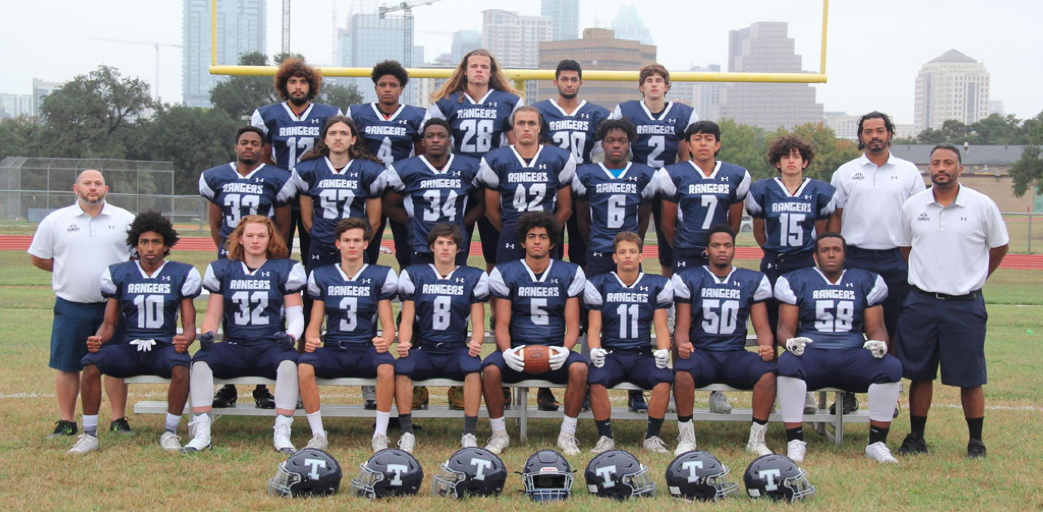
TSD Football alive & strong during the pandemic.
With several seniors who graduated last year and the devastating impact, Covid-19 has had on us, as well as the entire world, the Rangers football program had to make a pivot from playing 11-man to six- man ball, marking the first time in TSD history that the Rangers football team is playing six-man football.
Making that switch has been quite the challenge considering capacity restrictions limiting the use of our weight room and athletic facilities, and many scheduling conflicts to resolve to be sure our players were prepared for the season.
Fully prepared, we made our way to the TAPPS state finals. Our team caught the attention of many local and national news outlets, but we didn’t let the spotlight cause us to lose focus. We went to Hewitt, Texas, and defeated Veritas Academy with an impressive 63-32 score! Congratulations TSD Rangers Football team 2020, first time State Champions in our school history!
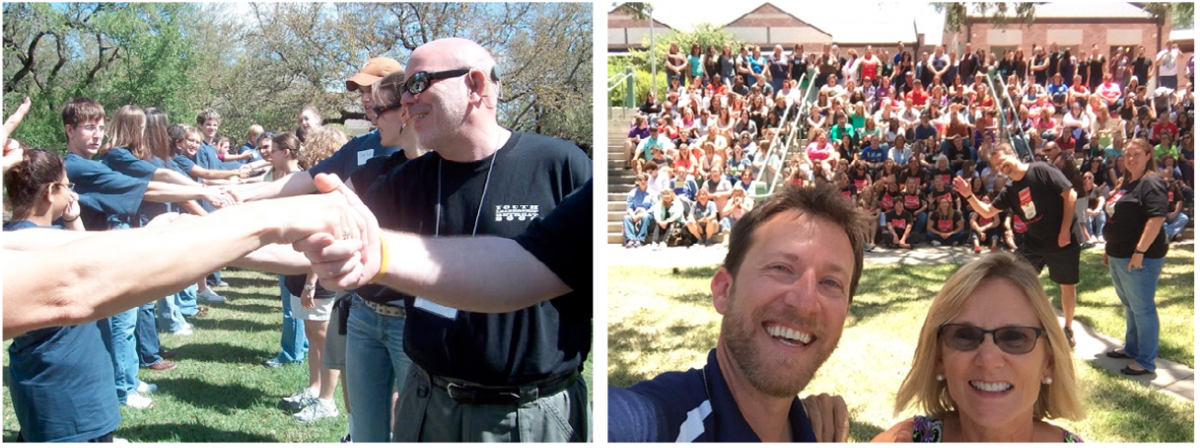
Many know the popular saying, “Rome wasn’t built in a day” but few are familiar with the second half of the phrase which states, “They were laying bricks every hour.” For many years, Texas School for the Deaf (TSD) has been laying bricks statewide to pave the way to better deaf education services. Those “bricks” have been made through funding, resource development, the use of current technology, the building of relationships/collaborations at the local, state, and national levels, and through deaf education and outreach staff expansion and leadership at TSD’s Statewide Outreach Center (see box on the history of Deaf Education in Texas).
The Beginning of TSD’s Outreach Services
Like many center-based schools, TSD began considering outreach when, after 1975, the interpretation of Public Law 94-142 resulted in more deaf and hard-of-hearing students being educated in their home districts. Then in 1977, the Texas Legislature mandated that in addition to its campus duties, TSD would
The resource centers that served TSD’s two campuses began creating and/or distributing materials, such as captioned films, for statewide use. Additionally, in 1982, TSD took over the Statewide Project for the Deaf that was housed on TSD’s campus but was run by the Texas Education Agency. The program was renamed The Center on Deafness and continued to offer the services that were already in in place including training, staff development, parent infant packets, and consultations.
This new view of the role of center-based schools led the Division of Public Services at Gallaudet College to launch the “Special Schools of the Future.” The project’s goal was to develop a framework for center-based schools to expand their roles to include regional or statewide centers on deafness. Seven demonstration schools across the nation were selected because they had
• strategic locations
• exemplary educational programs and facilities • supportive staff and administrators
• strong histories of public services
On June 1, 1989 TSD established its own Education Resource Center on Deafness (ERCOD) built largely on this original framework with a few minor tweaks. The one most significant precept of TSD’s model was to designate the entire school, all personnel and all services, as a resource to the state. However, one team took on the name of The Educational Resource Center on Deafness and has, since that time, led the outreach effort for the entire campus. The building blocks of TSD’s ERCOD are below and in the box following the list, are some highlighted programs that preceded TSD’s outreach framework and others that grew from its direction.
2. Curriculum/Materials/Technical Assistance Services 3. Parent and Family Education
4. Public Information/Relations and Referral
5. Sign Language and Interpreting Services
6. Specialized Programs and Services
7. Staff and Professional Development
8. Community Education Programs and Services
9. Research and Development Services
Highlights in the history of the development of TSD’s statewide services
• 1984 First Family Learning Vacation held at TSD (name changed later to Family Weekend Retreat and remains a strong ongoing program even facing the 2020 COVID challenges by moving to an online format.
• 1986 First two-week summer program offering computer literacy and performing arts. Summer programs have continued to expand and evolve. Now called summer camps and programs, it remains one of the most popular outreach offerings.
• 1987 First Summer Educational Interpreter Training (later name changed to Communication Skills Workshop).
• 2001 The foundation work begun for what becomes ASL Storytelling.
• 2004 Remote ASL Instructions Program: Pilot program started to use videophones to teach in-home sign classes. The name later changed to Family Signs and videoconferencing has become the means for service delivery.
• 2006 Parent to Parent Support through a variety of programs that really took off when TEA designated ERCOD as the state lead for Family Involvement.
• 2012 Birth to Three Services expanded.
• 2018 Online Resources expanded.
• 2020 Early Intervention Care Coordination, including Deaf and Hard of Hearing Mentors, expanded.
As the timeline of highlights show, every year the staff, programs, and services have continued to grow and evolve especially recently in the areas of online resources, videoconference technologies, and social media. This year, after 38 years of outreach efforts, another major development is a fresh new name for ERCOD. It is now called the Statewide Outreach Center at Texas School for the Deaf (SOC at TSD).
Putting Statewide at the beginning of the new moniker emphasizes that the work is bigger than any one entity. Itmust be inherently collective. It takes all of us to build our network, “brick by brick”, day by day, year in and year out. We all have come so far, but there is still a way to go. We are in it together for the long haul and we look forward to working with all of you for many years to come.
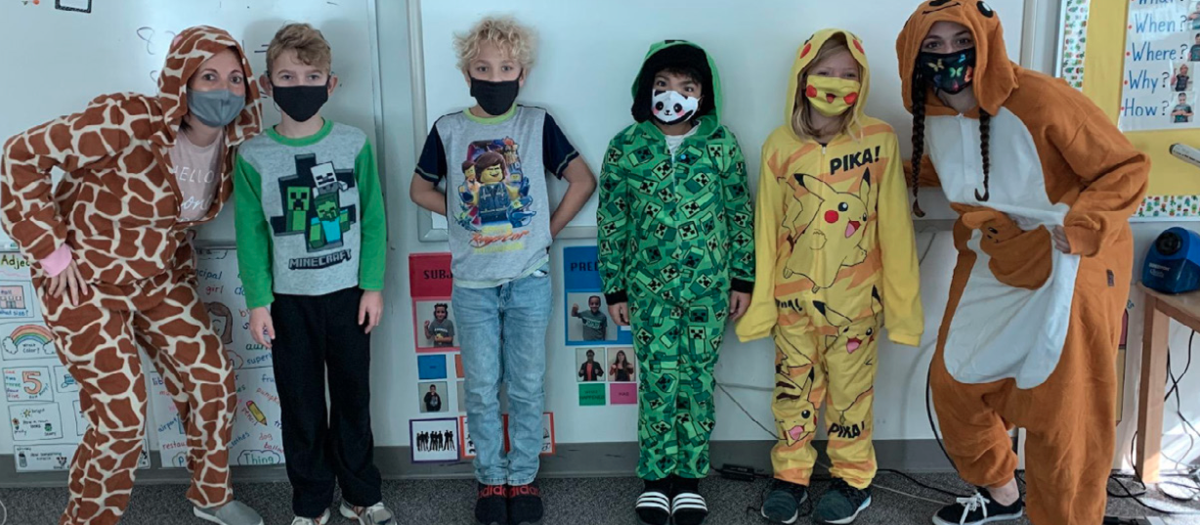
On Friday, March 13, 2020, excited children and staff departed the school building at the end of the day, ready to begin their long- awaited Spring Break. News of COVID-19 was becoming more prevalent, but no one was prepared for what was about to unfold. Within a matter of days, Superintendent Claire Bugen announced that TSD would join the growing list of school districts opting to close school for a few weeks in an effort to “slow the spread” of the virus. By the end of the month, Governor Greg Abbott had issued a Stay at Home Order for Texas. Statewide testing was cancelled for the spring/summer, and before we knew it, virtual learning was the new normal for the remainder of the school year.
It still came as a surprise to many that the 2020- 2021 school year would begin the same way. Instead of bustling hallways, on the first day of school students logged into their devices to greet their teachers and peers via Zoom video conferencing sessions. And like all schools, the first three weeks of learning was 100% virtual for all students.
In-person instruction resumed for the first time after Labor Day, but many families opted to keep their children home for online learning awhile longer. Only 12% of TSD’s ECE students returned for in-person instruction, while approximately 35% of our K-5 students returned to school in September. As the fall semester continued, more children returned to school as families weighed the benefits of in- person learning.
The “typical” school day looks quite different now in the midst of COVID-19 safety precautions. All faculty and staff are required to complete a self-screening prior to coming to work on campus each day, and students have temperature checks before boarding busses or getting out of cars at the drop-off line. Parents and guardians are expected to confirm their students are symptom-free, and kids immediately wash their hands as soon as they enter the building or their classroom. Hand sanitizing stations are found throughout the campus, being sure there are frequent opportunities for everyone to wash and sanitize their hands throughout the day.
All staff and students must now wear face masks, and there are multiple reminders to maintain the proper safe distance from others. In classrooms, desks are spaced to the greatest extent possible, and in some places, clear dividers have been installed to provide more of a barrier when distancing can’t be ensured. Feeling uncertain whether students might be overwhelmed by all of the changes and additional safety measures on campus, but we have been pleasantly surprised and inspired by the resilience of our young learners. Students have surpassed expectations and taken leadership to help each other follow the various protocols. To ensure cohesiveness all throughout our school family, staff members across campus are taking extra steps to connect and create positive relationships with, and among, students, and allow flexibility for creative routines this year.
The smell of disinfectant spray fills the air as students and staff are frequently wiping down surfaces and equipment. Students are not sharing and use their own supplies, with each storing their own materials separately. The water fountains across campus are unavailable. Instead, everyone has their own personal water bottle to stay hydrated. With how diligent everyone has been in regards to following these safety measures and ensuring proper sanitization, veteran ECE teacher Kelli Mills has noticed an increase in student attendance this year and that everyone seems to be less sick than in previous years.
Leslie also makes weekly deliveries of books students request, and helps younger students who aren’t ready to use the catalog, with a “book walk” where they get to browse and check out different library books that are displayed on the floor. Following safety guidelines implemented by public libraries, Leslie makes sure that all returned books are quarantined for 72 hours before they make their way into the hands of the next eager bookworm.
“We can’t go to the library each week, so on Fridays we return the books we’ve borrowed, and then we get new books we have chosen from the catalog on Mondays.” - Avalyn H., 4th grade
Recess looks a bit different now, too. At first, the playgrounds were closed, the swings were off limits, and toys/equipment were put away so students got creative inventing games and finding other ways to exert energy. Later, new safety protocols were implemented. Students can now use recreational toys and equipment that is sanitized daily, and everyone must wash their hands before and after using our new outdoor hand washing stations.
TSD parent and elementary STEM teacher, Nikki Beaver, took matters into her own hands to be sure students all had individual recess toys. Inspired by a friend in Georgia, Nikki quickly got to work and received over $600 in donations - enough to provide students in six classrooms each their own ball, jump rope, a Skip It, bubbles, sidewalk chalk, hula hoop, ball scoops, cones, rings, and frisbees. “All of the materials can be cleaned after each use, and students were excited when I shared the surprise via video,” she said. One third grader, Annabella B. was excited to see Nikki after the message went out, “I saw your video and am really excited to get to play with our new recess kits!” We thank Nikki for her initiative and hard work, and for all the families, friends, and others who contributed. “The community really stepped up, even some from as far away as Michigan.”
Some classes hold virtual morning meetings so that all students of that grade can participate together to connect regardless of whether they’re learning from home or in the classroom. Students enjoy different theme days when their class all does something special to connect - sometimes it’s dress-up in a certain way or other fun activities together. Prior to Halloween, teachers Justin Bergeron and Megan Canne, made special deliveries to their third grade students who are learning from home to be sure all students, whether in-person or virtual, get a chance at the same school experience to the greatest extent possible.
To prepare for the new school year and set teachers and students up for success, TSD began contracts a week earlier than originally scheduled so educational staff could focus on additional professional development and have extra planning time. Staff development will continue throughout the school year, with a focus on Conscious Discipline - a trauma- informed approach designed to teach students the social emotional skills they need to successfully navigate life.
To further support Social Emotional Learning (SEL), TSD recently added three new SEL coordinators to the faculty. Amy Holcomb, the SEL Coordinator for ECE/Elementary, says “SEL is an integral part of our everyday life. SEL focuses on skills that allow for connection, personal growth and success, safety, and communication. At the heart of all, students are able to communicate, think critically, and apply certain skills for self-management, self-awareness, social awareness, decision-making, and positive relationships.”
In addition to professional development centered around Conscious Discipline and Culturally Responsive Teaching, regular Curriculum Study sessions for teachers and administrators to look ahead and delve deeper to ensure we are maintaining quality instruction and meeting students’ needs. TSD strives to ensure our curriculum is reflective of multiple perspectives and provides opportunities for all students to engage in inquiry and take action. This helps develop students’ critical thinking skills and makes the learning process more authentic.
In TSD elementary, team teaching is helpful for larger class sizes. Third grade teacher Justin Bergeron is new to the profession and favors this teaching model. “I feel that team teaching is the most beneficial part of working at TSD. It allows us to really work together and share our ideas. I’ve always believed that multiple heads are better than one. With team teaching, I feel that it has allowed me to develop more quality lesson plans and ideas.” In a time when teachers need to accommodate both in-person and virtual students at the same time, the luxury of having a co-teacher has been a tremendous asset for our teachers and students alike.
Students have also become more adept with technology and how to work collaboratively with others in a digital environment. Amy Holcomb sees it. “Each individual is on their own journey in life, developing academically and socially. In elementary classes, we focus on learning opportunities through connection and ongoing dialogue.”
In the spirit of TSD’s 2020 - 2021 theme, we know for sure that “TOGETHER” is how we will best thrive.
Lone Star Journal • Volume 140 • Number 1 • Winter 2019-2020

By Stella Egbert, Director of Instruction
From providing services and instruction to our students, our teachers have developed plans to best meet the needs of their students. Some examples include whole class meetings to stay connected and maintain our focus on SEL (social emotional learning), small group instruction in order to focus on academic skills, and individual sessions designed to work on specific areas of need and IEP goals. Some students focused more on their transition plans and what goals they have been working on all year long in preparation for the summer. Career counselors are reaching out to our seniors to support their plans after completing their last year in high school. Our school counselors and speech therapists have begun tele therapy and connecting with their students.
There have been many opportunities for reaching out to our students and their families in a variety ways that go beyond individual and group instruction. The TSD PE Department is also posting weekly challenges and fitness sessions and resources are available on their weblink. Some of teacher assistants are providing families ASL—this has been a positive opportunity for us to connect with our many families.
While we would prefer to be together on campus, we are grateful for technology and being able to continue learning and growing together. We look forward to seeing our school community strengthen together during this unprecedented time.
On March 11, Bugen issued the first announcement to assure the community that Texas School for the Deaf (TSD) was taking precautions with the safety of students and staff top of mind. Moving forward, the Superintendent continues to provide ongoing updates and quick access to the latest school news on a special web page by clicking the top banner on the TSD home page, www. tsd.state.tx.us. The TSD campus was officially closed to all staff and students, except those who are essential to TSD operations, as of March 16.
Immediately, both TSD and its’ Educational Resource Center on Deafness (ERCOD) quickly worked to ramp up efforts to provide online instruction as well as technical assistance and resources for students, families, educators and community partners. Along with new lessons, tips and tools being continuously added, ERCOD’s Crossroads website https://www.texasdeafed.org/ has been retooled to provide quicker and more intuitive access to lesson plans and the resources you’re looking for.
During the process of shutting down campus, TSD’s Information Technology department and core administration staff remained to ensure the necessary equipment, technical assistance and support was available as most everyone prepared to work at home. Enterprise-wide tools, such as Zoom video conferencing were rolled out and additional support for PowerSchool was made ready for faculty.
As the pandemic continues, a new normal emerges for education heavily reliant on visual communication and total access for all students. TSD now holds staff meetings and regular check- ins via video conferencing, providing support to one another as we all ramp up our knowledge of technology and online solutions, to ensure that educating deaf and hard of hearing children continues.
While it is business as usual with everyone working from their homes, to keep spirits high during this time of isolation, the ERCOD team has tried to remain social through some virtual fun, using an online scavenger hunt app sharing photos/videos to complete specific “missions.” Encouraging everyone to get outside with nature at least once every day has proved important for well-being. The scavenger hunt has been a fun way to stay in touch with team members, check in on each other and ensure that everyone stays well physically and mentally.
The highlight of ERCOD’s week one scavenger hunt challenge was a photo of ERCOD Director, Dr. Bobbie Beth Scoggins, hanging from a tree to earn points for her team!
If anything, the experience of this unprecedented pandemic has sparked creativity and tenacity from us all who proudly serve both missions of TSD and all deaf and hard of hearing students of Texas.
To paraphrase Britain’s Queen Elizabeth II’s recent address to the United Kingdom, which outlines the mindset and sense of strength we all might aim to adapt as one global nation - together:
“We will succeed — and that success will belong to each and every one of us. We should take comfort that while we may have more still to endure, better days will return. We will be with our friends again, we will be with our families again, we will meet again.”
We will meet again, Rangers. As always, we remain a TSD family.
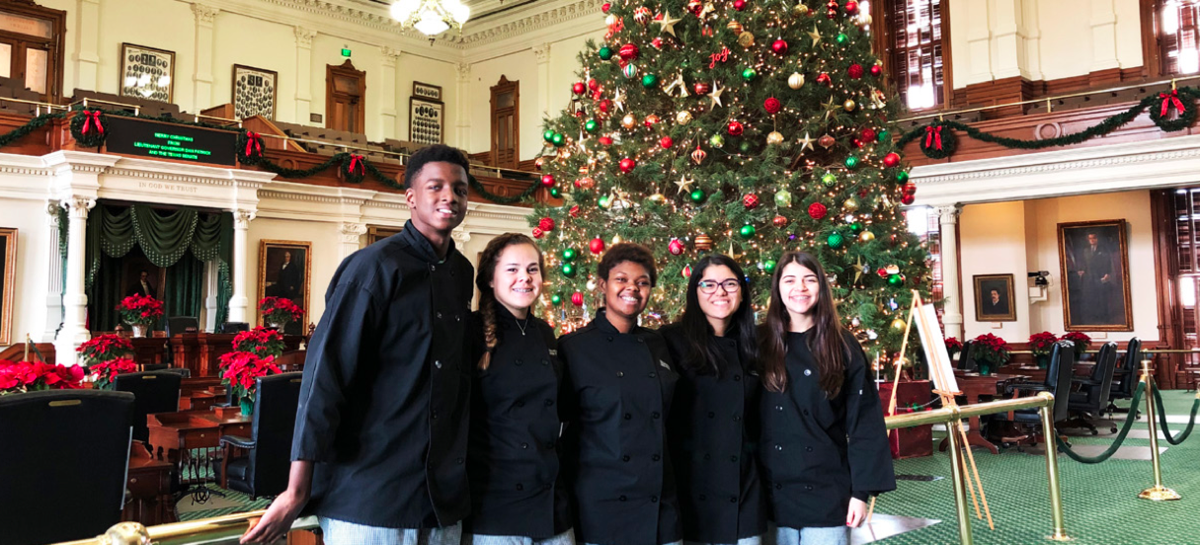
This year TSD went big! Considering important Deaf-friendly bills had been passed during the recent legislative session - one of which included funding for TSD’s culinary arts program – it was important to acknowledge TSD’s deep gratitude for our state lawmakers and their hardworking office staff members.
Having studied up on their Texas history and current state issues - especially those concerning Texas’ Deaf citizens and TSD - the students introduced themselves and shared their heartfelt appreciation to all of TSD’s constituents for their hard work and support.
Excited to receive the delicious assortment of holiday cookies, Senator Zaffirini was able to sneak out of a conference call to greet the students. The Senator mentioned her work on two important legislative bills that she’d helped push through, (1) HB 548 concerning acquisition for children, eight and younger, to prevent language delay or deprivation, and (2) SB 281 when drafting legislation, to remove old terminology used to address Deaf individuals.
When meeting Senator Watson who is another strong advocate for the school, he fondly greeted the group and thanked them for the cookies, noting how proud he is of the programs at TSD.
Shortly thereafter, Senator Watson announced his retirement from the state Senate as of April 30, 2020, having been named founding dean of the University of Houston Hobby School of Public Affairs. Without question, TSD will miss Senator Watson’s loyalty at the capitol.
The group fortunately found Representative, Eddie Rodriguez in the office, who was thrilled to meet the students. Rodriguez represents Texas House District 51, which includes TSD. The students especially enjoyed visiting his office suite which is located on one of the upper floors of the capitol building facing south down Congress Avenue, with a view of TSD, if you really look hard.
At the final stop at the TFC, Mike Novak welcomed the students to his office and invited them to sit on the commissioner’s dais. An important partner agency of TSD’s, TFC maintains the campus facilities, grounds and heads up any new construction.
In total, students made cookie deliveries to the offices of Governor Greg Abbott, Lt. Governor Dan Patrick, House Speaker Dennis Bonnen, Senators Jane Nelson, Larry Taylor, Joan Huffman, Nathan Johnson, Eddie Lucio, Jr., Donna Campbell, House members Donna Howard, Mary Gonzalez, Drew Darby, Matt Schaefer, Oscar Longoria, Erin Zwiener, Terry Canales, Trent Ashby, the Legislative Budget Board, the Senate Finance office, the House Appropriations office, the Legislative Committee Coordinator’s office, the capitol officers of the Department of Public Safety, and our partners at Texas Education Agency.

“We are thrilled to be back in our home, and ready to bring the community some great theatre,” said Director, Brian Cheslik. “While the changes that are visible to the audience are minor, the changes backstage are wonderful.”
The 2019 middle school production of The Brothers Grimm Spectaculathon provided a fast-paced mash up of all 209 stories collected by Jacob and Wilhelm Grimm during the early 1800s. Popular children’s stories such as Rumpelstiltskin, Cinderella, Hansel & Gretel, and Rapunzel were all included along with the more obscure stories such as Lean Lisa, The Pack of Ragamuffins and Straw, Coal, & Bean.
The cast included eight middle school students becoming an acting troupe here to present their play. The show was guided by eighth graders, Julius Cardenas and Alma Robinson, as the narrators for the show. Robinson’s superior attitude and desire to present a serious show was contrasted by Cardenas with his wacky personality. The remaining actors, Jasmine Hottle, Gwendolyn Meredith, Jovie McKee, Shanna Gobble, Frankie Ramirez and Ti’Jean Chin Sue, worked together as they all portrayed a total of 21 different characters, often on stage at the same time.
Assisting the production were Joe Cherichello and Ima Faith Hernandez - two high school seniors who interned as production assistants, Assistant Director - Stephanie Hurwitz, and Student Development Assistant - Tori Beard.
“This production was a handful and I could not have done it without such an amazing support team,” Cheslik added.
The TSD Performing Arts Program is currently in rehearsals for the high school production of You’re a Good Man, Charlie Brown, set to open Spring of 2020. Be sure to check it out! You can also follow the TSD Performing Arts Program on social media to stay up to day on everything they are doing, on Facebook: @TSD Performing Arts Program, and Instagram: @tsdperformingartsprogram
